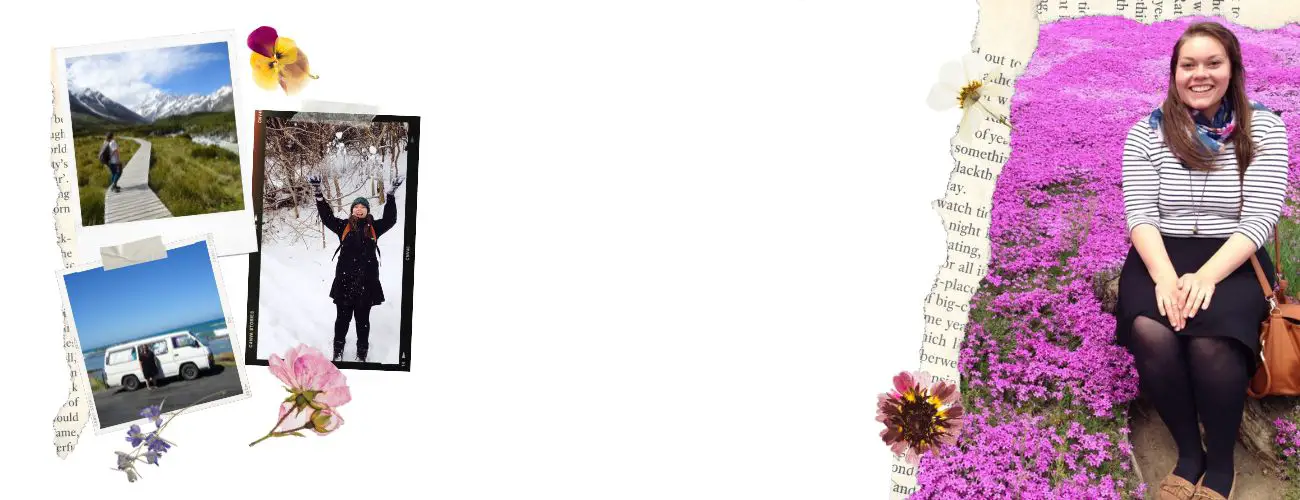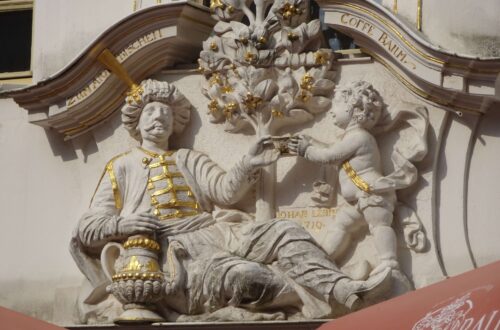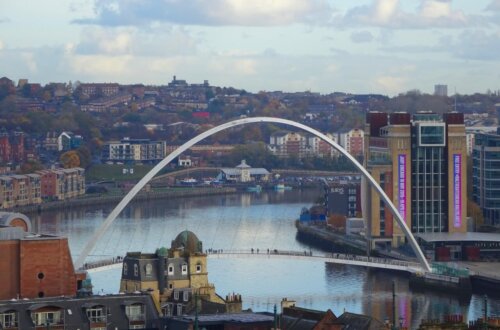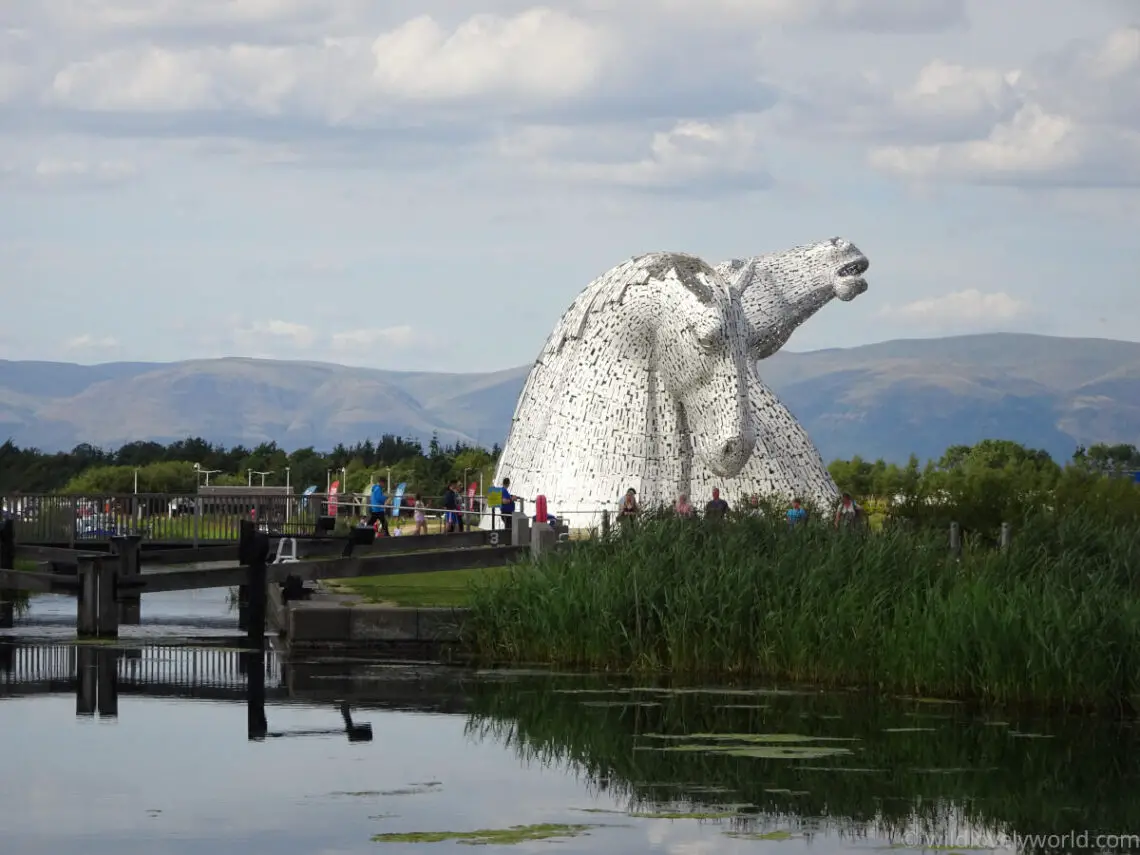
The Kelpies In Falkirk: Visit The World’s Largest Horse Sculptures
Last Updated On 6th February 2024 By Lauren | Wild Lovely World
Home » Blog » Europe » Scotland » Falkirk »Falkirk is a charming small Scottish town. It is famous for its industrial history as it is the location of the Forth & Clyde Canal. Today, Falkirk is the home of the Kelpies, massive sculptures made from steel in the shape of horse heads.
The huge 30m sculptures and amazing design have become an iconic symbol of Falkirk and a must-visit destination for travellers from around the world.
A visit to the Kelpies in Falkirk makes a great day trip from Edinburgh or Glasgow. The Kelpies are located just 40 minutes away by car, or 1.5 hours by public transport from both cities. You could also visit the unique sculptures en-route to Stirling and the Highlands, as it makes a great rest stop.
The Kelpies are set against a beautiful backdrop of rolling hills and the calm waters of the canal. You’ll be able to take lots of beautiful photos whether you visit during the day or at night when the Kelpies are lit up in beautiful bright colours!
The Kelpies are located within Helix Park and there are many fun things to do nearby. You can take a leisurely walk along the canalside pathways and learn about the history of the local area, tracing the footsteps of generations gone by.
Visiting the Kelpies is a magical encounter with Scotland’s folklore, as the sculptures are inspired by the mythical water spirits called Kelpies.
Whether you love art, history, or simply want to explore Scotland, a visit to the Kelpies is a wonderful way to spend the time.
In this post, we will look at how to visit the Kelpies in Falkirk and get a closer look at these iconic sculptures.
Complete Guide For Visiting The Kelpies & The Helix Park In Falkirk, Scotland
More amazing Scotland blog posts for your travel inspiration!:
- 13 Best Free Things To See & Do In St Andrews | Scotland
- The Best Hikes & Walks From Corrour Station
- Corrour Station: How To Get There On The West Highland Line
- The Seven Hills Of Edinburgh: A Quick Guide
- Calton Hill Guide: Easy Walk & Famous View Of Edinburgh
- Autumn In Edinburgh: The Best Places To See Colourful Leaves
- Edinburgh Christmas Markets & Fairs: What’s On
- 7 Best Wild Camping Sites On The Isle Of Arran
- How To Get To The Isle Of Arran From Edinburgh (By Car & Public Transport)
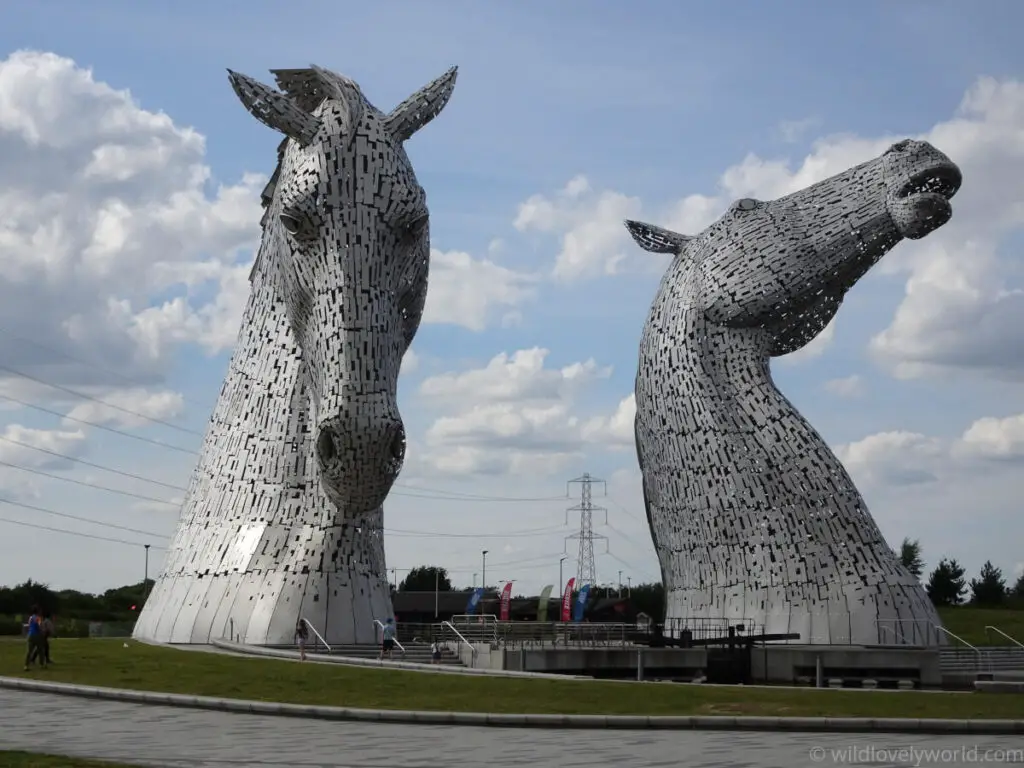
FAQ: The Kelpies Falkirk
About The Kelpies FAQs
Visiting The Kelpies FAQs
Visiting Helix Park FAQs
Travelling To The Kelpies FAQs
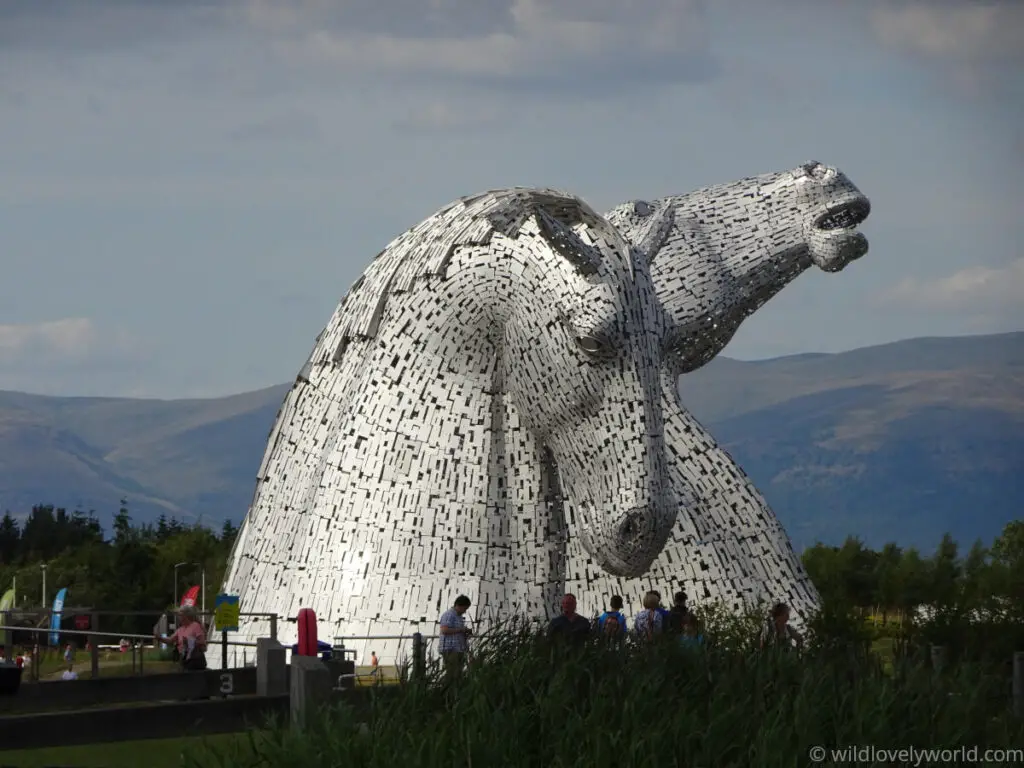
What Are The Kelpies In Falkirk?
The Kelpies are two giant sculptures of horse heads located in the small town of Falkirk in Scotland. They are the largest equine (horse) sculptures in the world!
Each sculpture is 30 metres (100ft) in height and weighs 300 tonnes. The sculptures are made of steel.
The Kelpies stand majestically above the loch and basin of the Forth & Clyde Canal.
The steel sculptures pay homage to the working horses of Scotland which used to pull barges along Scotland’s canals and worked in the fields in the area where they now stand.
Although they are called Kelpies, which is a mythological water spirit in Scottish folklore, the Kelpies sculptures are a modern take on the horse.
The folklore of the Kelpies inspired the artwork because the sculptures are located next to the basin of the Forth & Clyde Canal.
The idea was to celebrate horses’ role in industry and agriculture including their work on the canals, as well as Scotland itself. Scottish artist Andy Scott designed the Kelpies.
The Kelpies sculptures are one of the best-known and the largest public artworks in Scotland.
The Kelpies are now a huge tourist attraction in Scotland with millions of visitors since the site opened in 2014. It is completely FREE to visit the Kelpies and they are open 24/7.
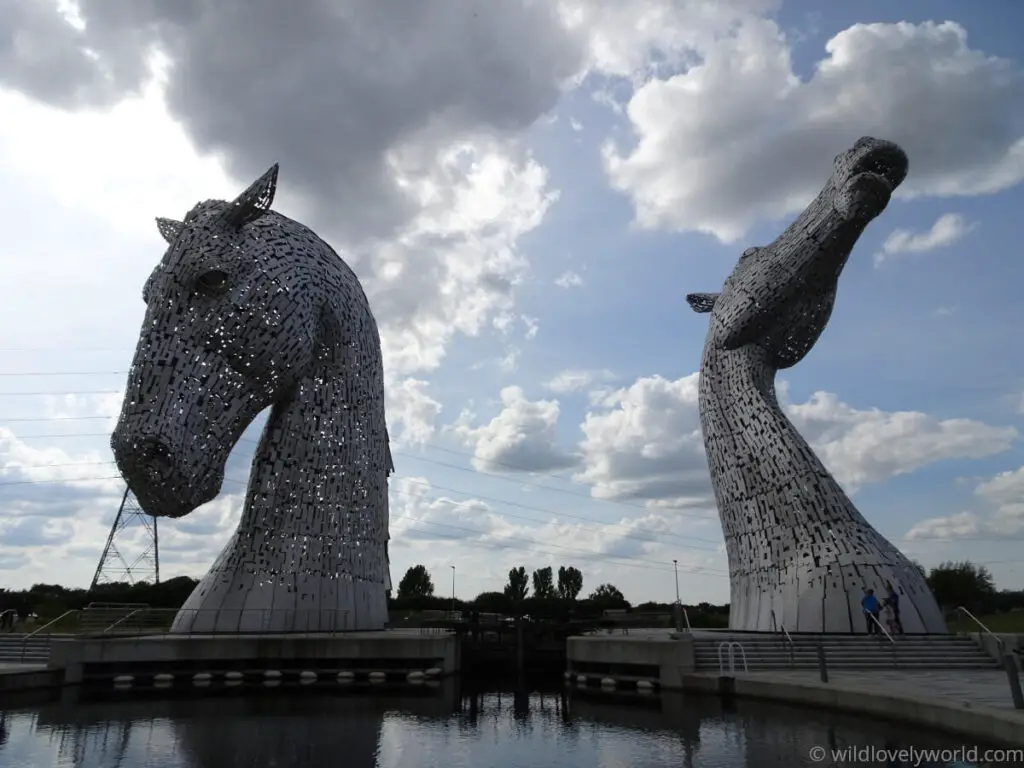
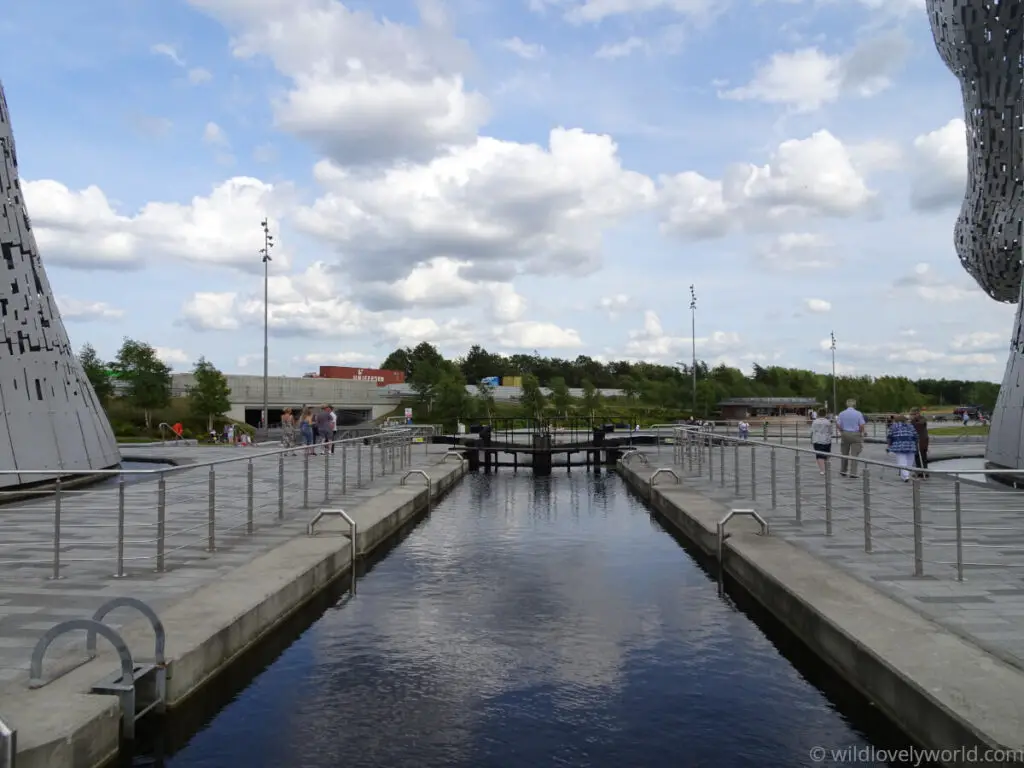
Who Designed The Kelpies?
The Kelpies were designed by Scottish sculpture artist Andy Scott.
Andy Scott is from Glasgow in Scotland.
He makes sculptures using galvanised and stainless steel and cast bronze.
Horses are a recurrent theme in his work.
The Kelpies are Andy Scott’s most well-known and famous sculpture, but his works have been featured all around the world in a variety of public settings.
You can learn more about Andy Scott and see more of his work on his website.
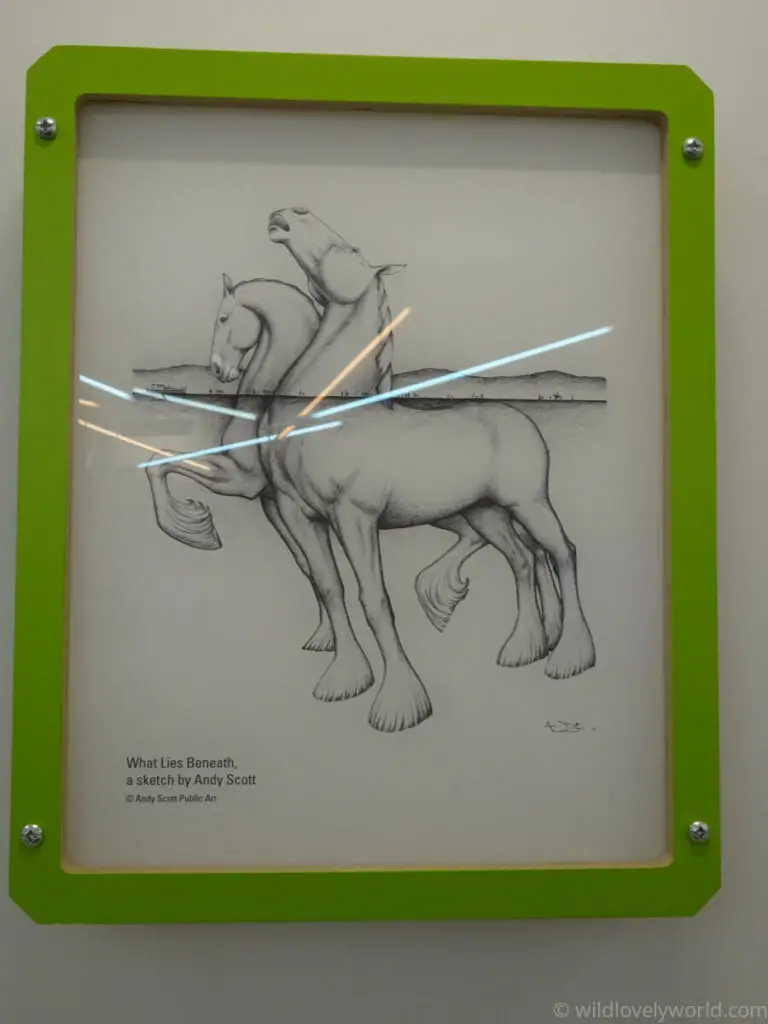
How The Kelpies Were Designed & Constructed
Andy Scott’s vision for The Kelpie sculptures began 8 years before it was made a reality.
The design process to make the giant Kelpies involved Andy Scott making smaller, scale models of the sculptures. The scale models were about 1/10 of the size of the giant Kelpies we can see today in Falkirk.
Each scale model sculpture of The Kelpies was made from hundreds of small, hand-cut steel plates. These steel plates were then welded onto a horsehead skeleton of steel bars. This is much like how the final, giant Kelpies are made.
The 3m high-scale models were then scanned into a computer that could recreate a computer 3D model and show the design of the thousands of components needed to make the final giant Kelpie structures.
The steel plates were then constructed in factories by a team. Fabrication of the steel plates began in the autumn of 2012. Usually, Andy Scott does everything by hand himself, but for a project of this scale, he needed a team to help him!
When all the materials were ready, The Kelpies were put together on-site at the canal in Falkirk during the summer and autumn of 2013. The Kelpies were constructed by giant cranes, similar to how ships are built. Each head took 75 days to construct.
By spring 2014, the whole site was ready to welcome visitors. The Helix Park is the home of the Kelpies.
Reference: The Man Who Created The Kelpies, BBC Scotland, May 2014
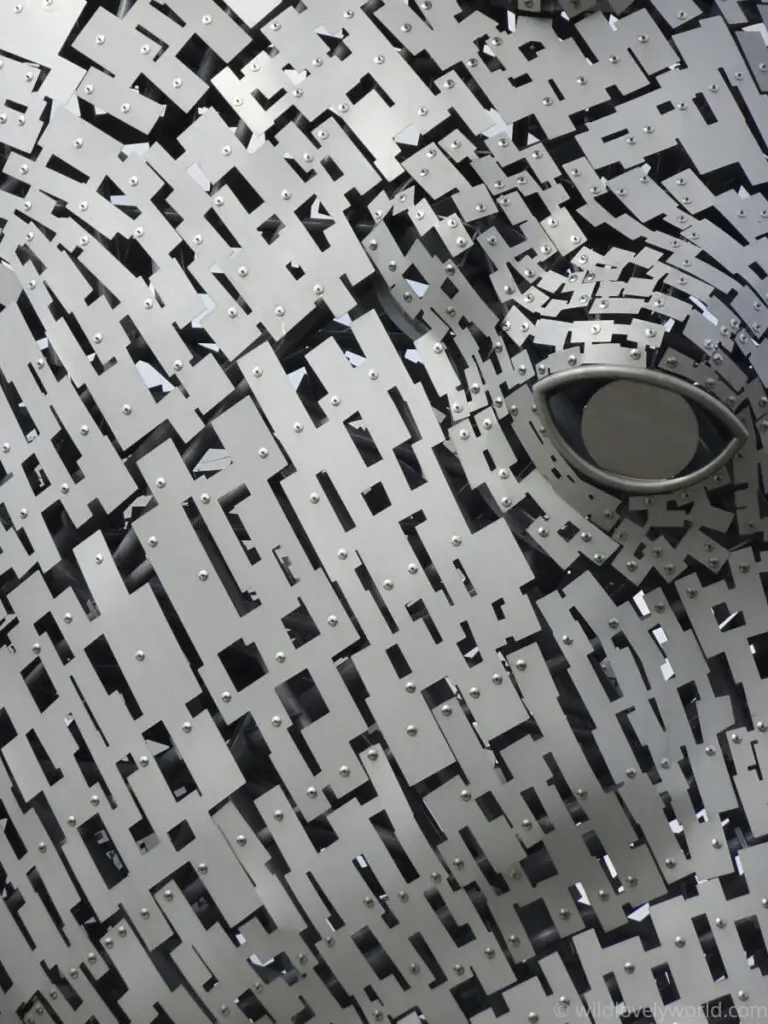
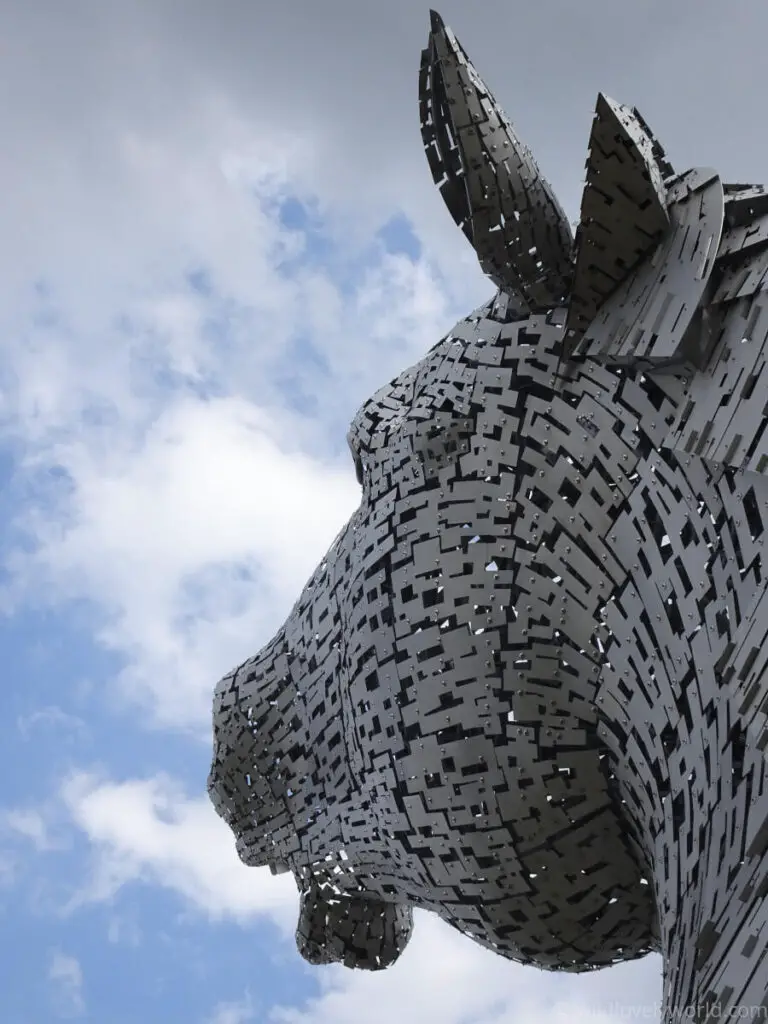
What Is The Story Of The ‘Real’ Kelpies?
The Kelpie sculptures are two massive horse heads, one facing up and one facing down.
They were modelled on two real horses called Duke and Baron. They were Clydesdale horses, which is the breed of horse often used on canals.
The two horses were under the care of Glasgow City Council. Both horses were rehomed by the council after being in horse sanctuaries and under the care of World Horse Welfare. The charity helps rehome horses and make sure they are looked after. Glasgow City Council rehomed the two horses, Duke and Baron, to work at Pollock Country Park.
When Andy Scott was in the process of designing his Kelpies sculptures, he asked the council if they had any horses that would be a suitable model for him. Duke and Baron were chosen to be the models.
Duke became the model for the ‘head-down’ Kelpie, while the slightly larger Baron modelled for the ‘head-up’ Kelpie.
The sculptures are referred to as ‘Head Up’ and ‘Head Down’. But many people still call The Kelpies by their real-life names, Duke and Baron!
Now the two horses are forever immortalised as The Kelpies!
You can see pictures of the real-life horses used as models for The Kelpies in this article at Glasgow Live.
Reference: The real-life Clydesdale horses that inspired the iconic Kelpie sculptures, Glasgow Live, February 2022
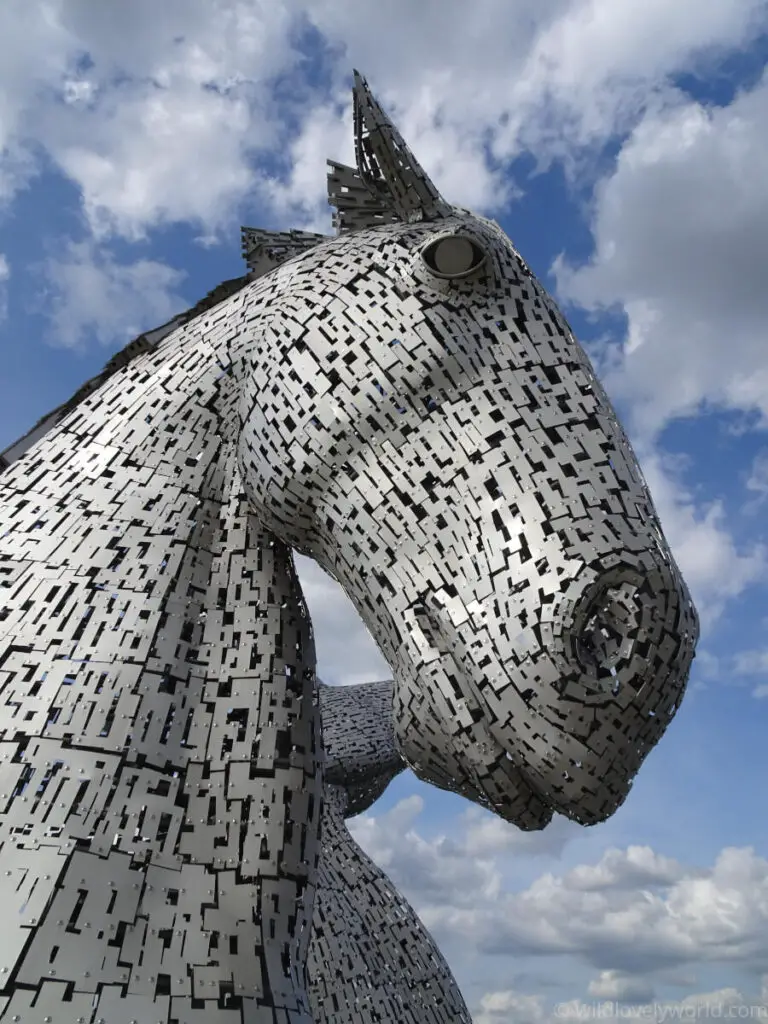
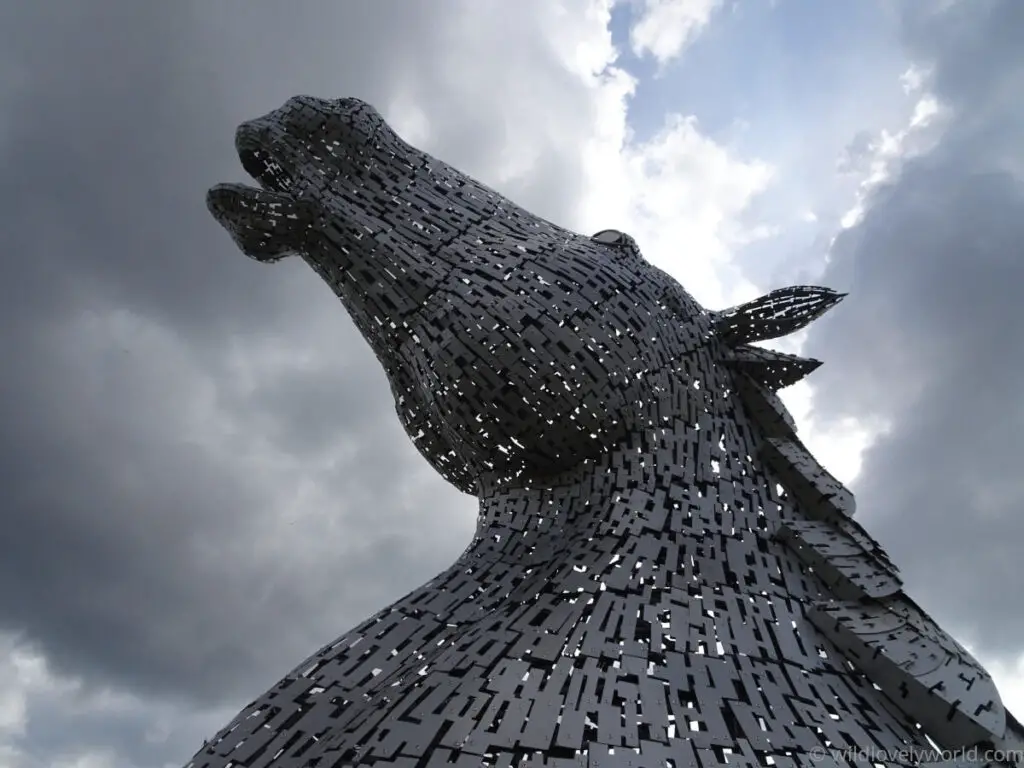
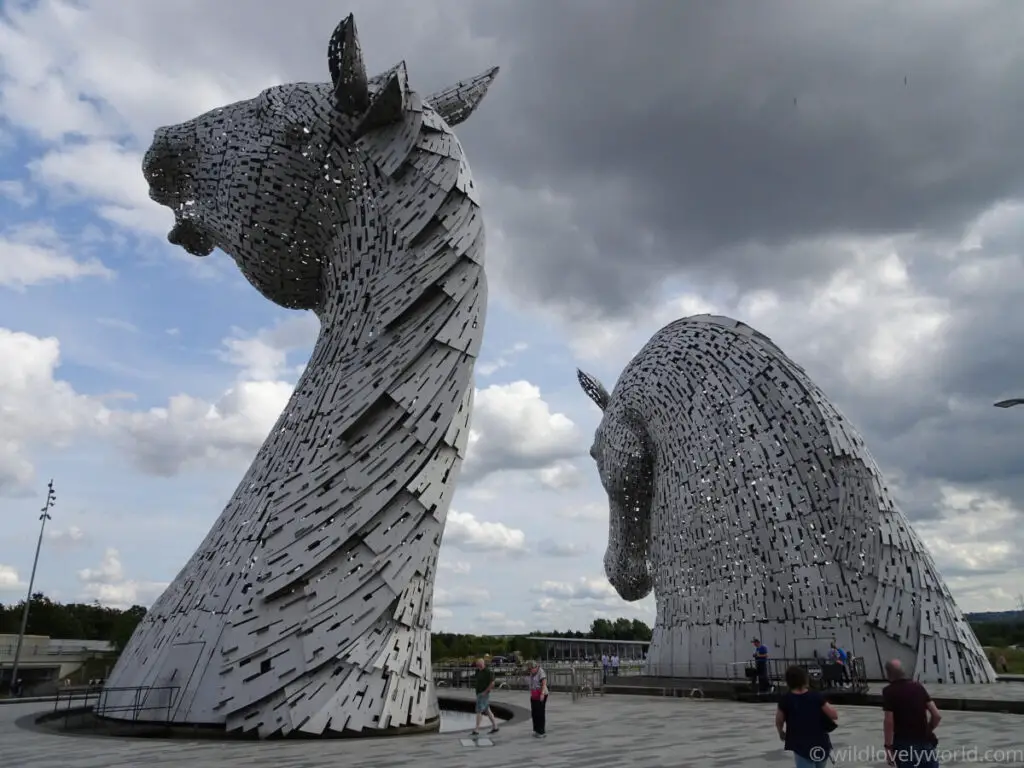
What Are Kelpies In Scottish Folklore?
A Kelpie is a mythical creature of Scottish Legend. As shape-changing aquatic spirits, the Kelpies usually take the form of a horse but sometimes a human. Haunting rivers, streams and lochs, the Kelpies will use their beauty and allure for malevolent means.
Appearing as a tame horse, for instance, the Kelpie would attract children to ride on its back, where it would then jump into the water and pull the children under and eat them.
Appearing as a beautiful young woman or a big hairy man, the being could then pray on unsuspecting travellers and drag them deep into the water for the same spooky fate.
Robert Burns’ Poem About A Kelpie
The famous Scottish poet Robert Burns wrote about the Kelpie in ‘Address to the Devil’ written in 1785:
“…When thowes dissolve the snawy hoord
An’ float the jinglin’ icy boord
Then, water-kelpies haunt the foord
By your direction
And ‘nighted trav’llers are allur’d
To their destruction…”
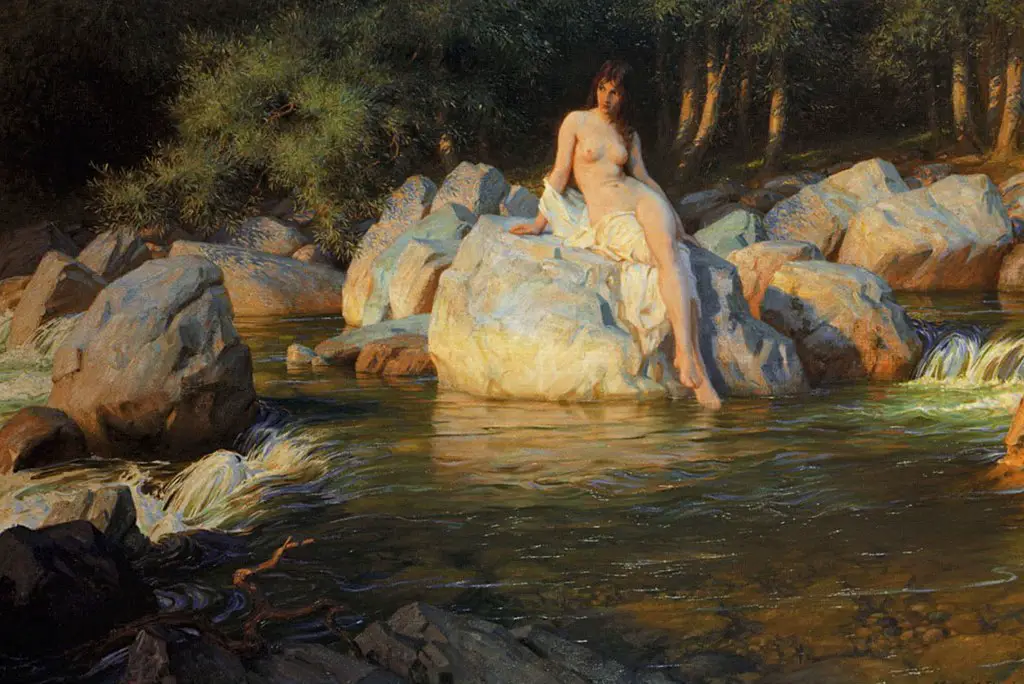
What Does The Folklore Of The Kelpies Mean?
The tale of the Kelpies was often told to young Scottish children by their parents as a way to encourage them to stay away from the water. Some were told that even if they got too close to the water’s edge, the frightful Kelpies could jump out and grab them before pulling them back in, much like a crocodile praying on a water buffalo.
Kelpies could also have been used as a warning for people not to trust strangers as they are travelling unfamiliar paths.
Additionally, the idea of Kelpies pulling people beneath the surface of the water could have been used as an “explanation” for people drowning in rivers and lochs in Scotland.
Spooky Kelpie Folklore Stories
I have visited the Kelpies many times, but I once went on a guided tour to the Highlands in Scotland and on the way we passed The Kelpies in Falkirk. The tour guide told us some interesting folk tales and stories about the Kelpies in Scottish folklore. It was the first time I heard many of the stories and I found it really interesting!
If you have an opportunity to do a guided tour, then your guide may entertain you with some of these spooky stories! You could join a small group day tour with Rabbies or Timberbush (GetYourGuide). These fun guided tours are a fun day trip that not only visits the Kelpies but also Stirling and Loch Lomond.
View the day tours from Edinburgh to see the Kelpies, Stirling Castle and Loch Lomond (the ‘Highlands in Minature’) below on GetYourGuide:
You can read more about some of the folk tales of Kelpies on the Wikipedia page – there are some interesting ones!
Going Inside The Kelpies – Guided Tour Of The Kelpies
The Kelpies are completely FREE to visit and admire from the outside, but if you want to go inside you need to book a tour.
The 30-minute guided walking tours take you inside one of the Kelpies so you can truly see the engineering and design. You’ll also learn about the vision of the artist, Andy Scott, and how the history and industry of the local area impacted his design of the Kelpie sculptures.
A Kelpies tour costs £7.50 for each adult (kids go free with two paying adults and concessions are available). You can book online or buy at the Visitor Center when you arrive. The tours operate at several times throughout the day (10 am – 4 pm).
The Kelpies tours are daytime only and not at night.
In my opinion, admiring The Kelpies from the outside is a wonderful way to visit them. If you really want to see what it looks like from the inside, you can always peer in through the gaps in the steel panels!
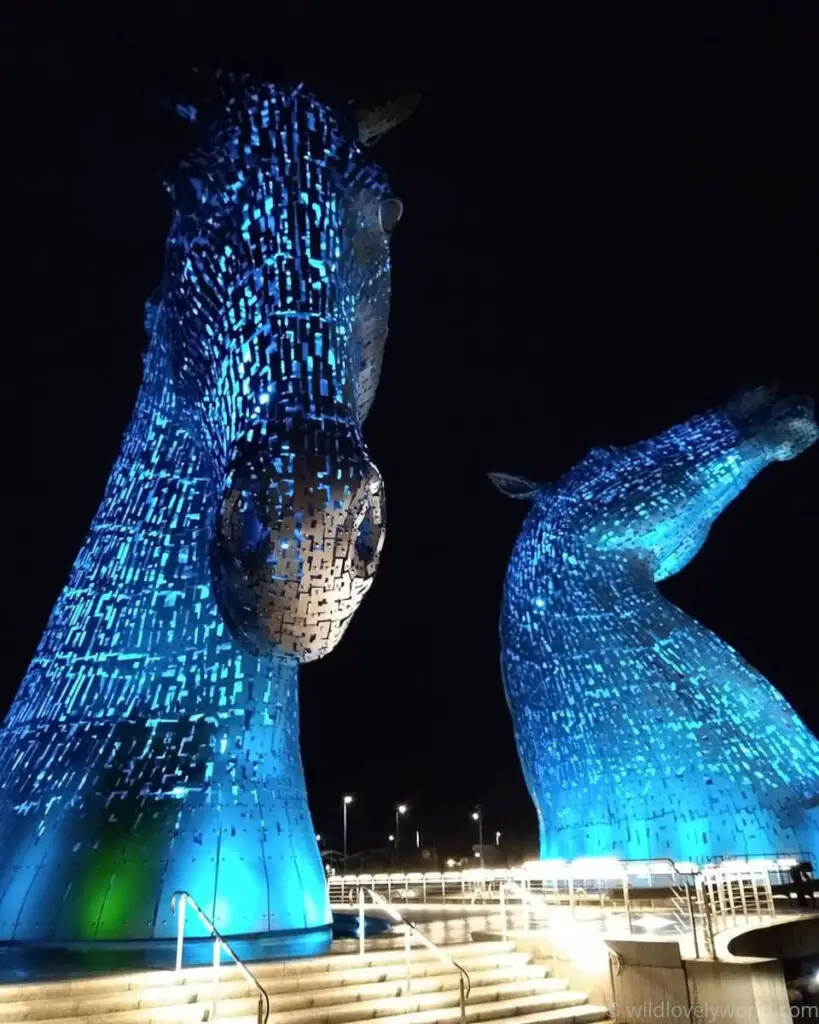
Visiting The Kelpies At Night
If you visit The Kelpies at night then will be able to see them lit up in bright and changing colours. Light projects onto the Kelpies and the colours change and shift through all colours of the rainbow! You can enjoy seeing the Kelpies in blue, red, green, purple and many other colours.
If you can, it’s worth seeing The Kelpies in both the daytime and nighttime! If you can make your visit time to just before sunset then you’ll be able to see them in both daylight and at night.
The Kelpies light up every night, 24/7, every day of the year!
The sculptures look stunning lit up at night, so it is definitely worth visiting The Kelpies at night if you have a chance.
If you do visit at night then most of the facilities will be closed as they open between 9:30 am – 5 pm depending on the time of year. The toilets at The Kelpies car park should be open until 10 pm.
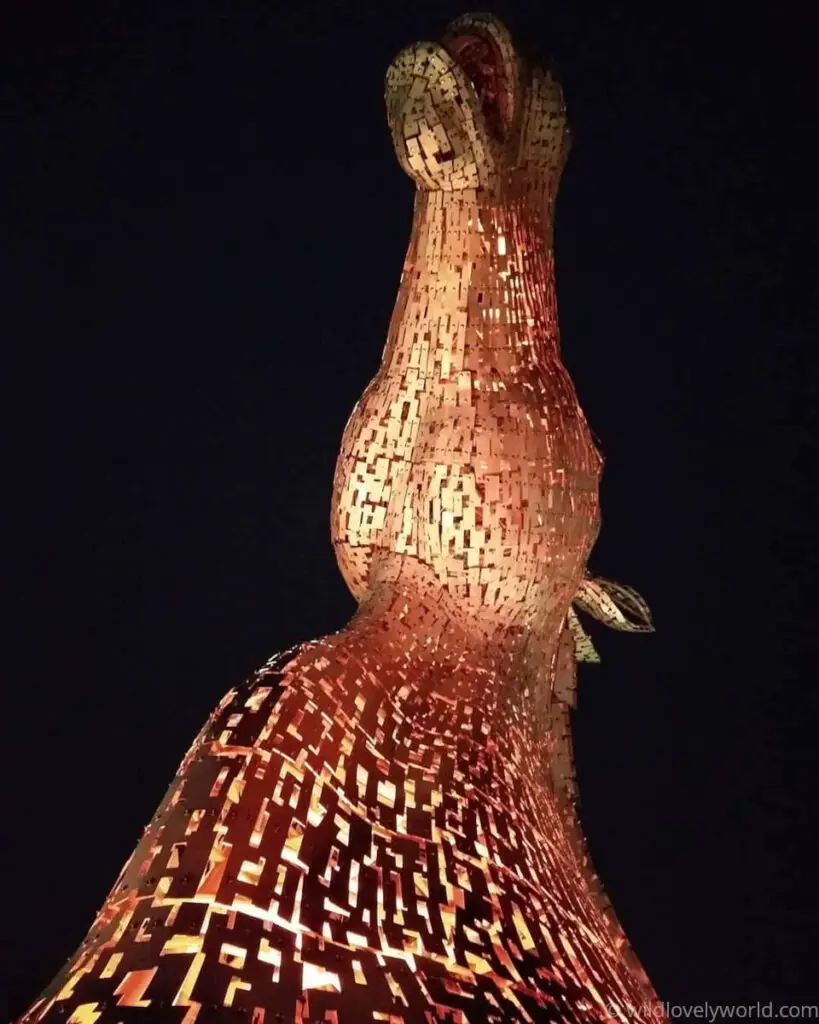
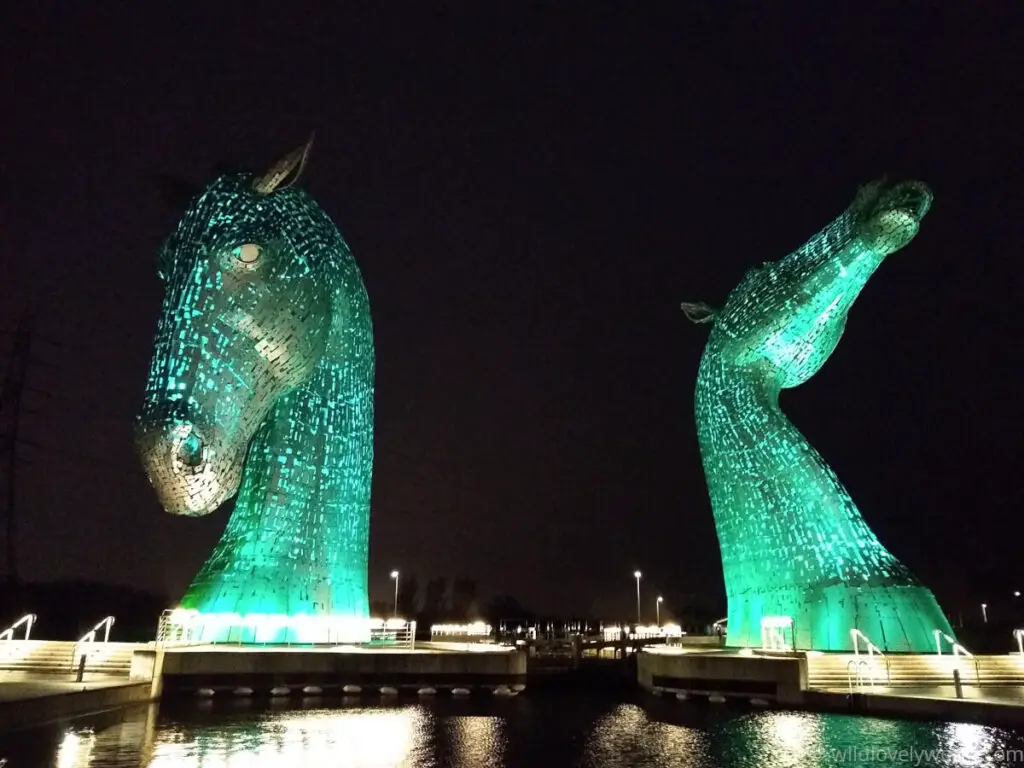
How Long Does It Take To Visit The Kelpies?
How long you wish to spend at the Kelpies is entirely up to you!
Many people will spend around 20 minutes looking at the Kelpies and taking a quick photo. This is a good option if you are short on time and want to see the Kelpies on the way to visit Stirling or go to the Highlands as part of a road trip.
If you have more time then it is well worth spending a couple of hours taking in all the Kelpies and the Helix Park has to offer.
The Kelpies are located within Helix Park which has acres of green space, wetlands and trails to enjoy walking or cycling. There are the canals to look at as well as the Visitor Centre where you’ll learn more about the Kelpies and the surrounding area.
When I visited the Kelpies I spent around 2 hours exploring the whole area, which included taking a walk along the canals and looking at the exhibits in the Visitor Centre. I also spent a lot of time taking photos of the Kelpies!
If you’re visiting the Kelpies at night then around 30 minutes will be plenty of time to enjoy wandering around the Kelpies and enjoying the beautiful colourful lit-up display of the sculptures at night.
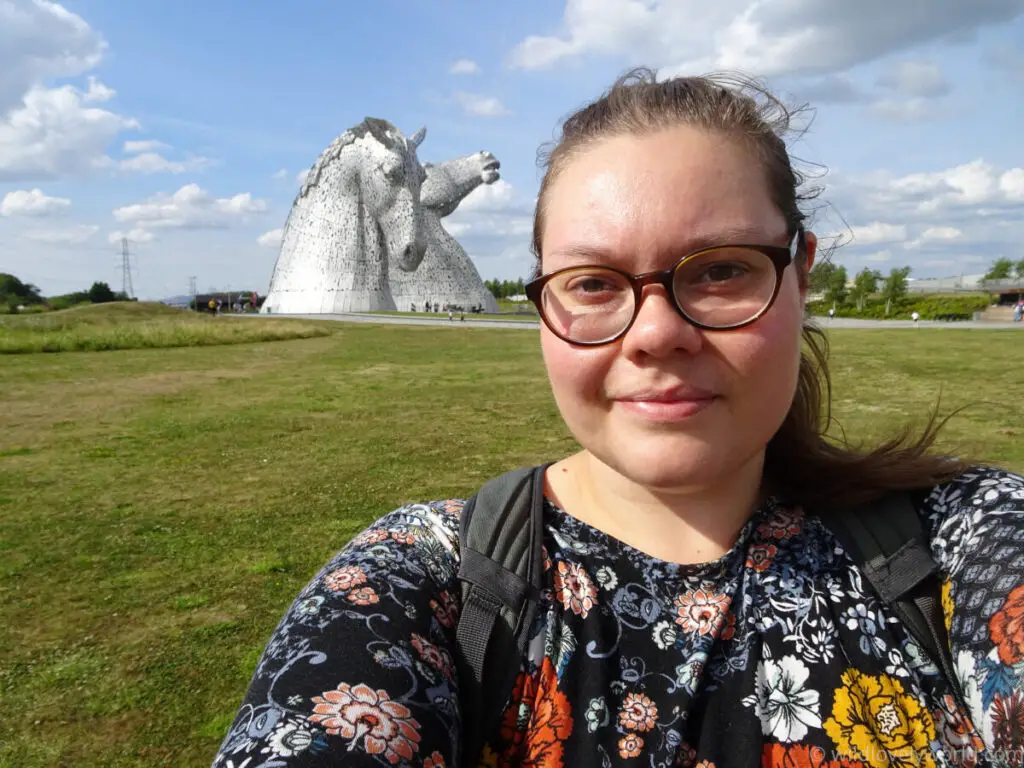
The Helix Park In Falkirk – Home Of The Kelpies
The Helix Park is the home of the Kelpies but it is also much more than that. Helix Park was created for the community and visitors to enjoy as a recreation area.
There’s no doubt that The Kelpies are the main attraction at the park. But there is also a visitor centre, adventure play park and walking and cycling trails at Helix Park.
There are plenty of green spaces to enjoy, a timbered boardwalk over the wetlands and lagoon and the Helix Park pond.
Here are ideas of the best things to see and do at Helix Park.
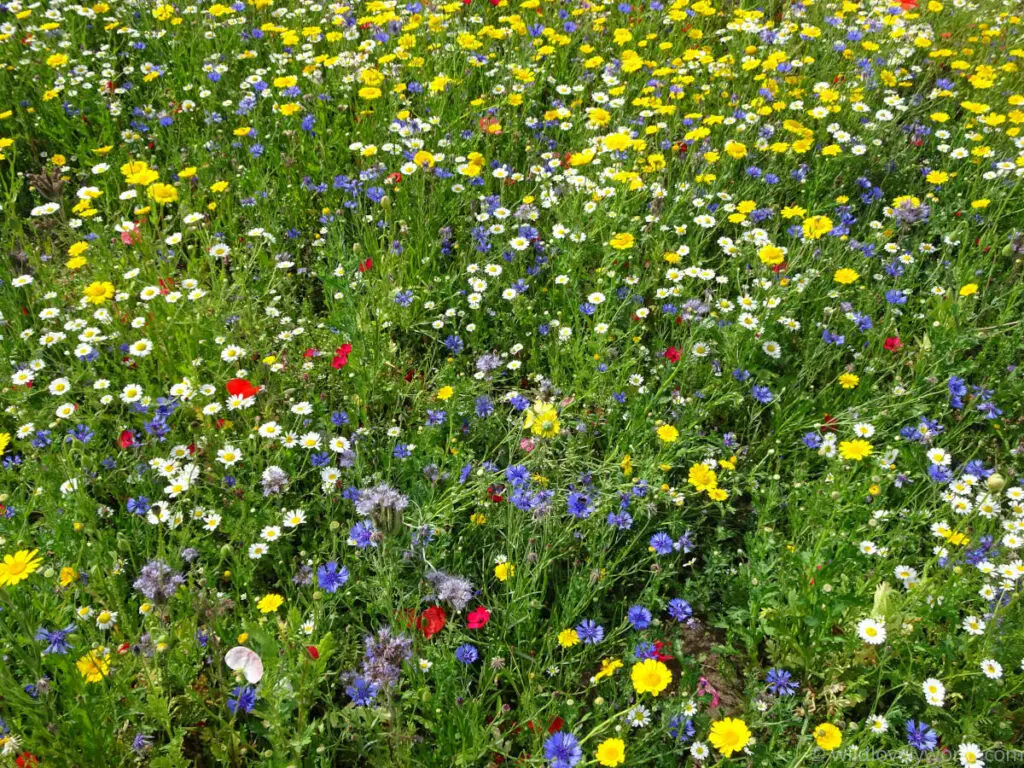
Best Things To Do At Helix Park
The Helix Visitor Centre
There’s a Visitor Center on-site at The Helix Park, opposite the Kelpies sculptures. Inside the centre is a shop, cafe and toilets, as well an educational centre where you can learn about the history of the area and how The Kelpies came to be.
The Visitor Centre at The Helix/Kelpies is open all year round from 9:30 am – 4 pm, 7 days a week. From April – October, the centre is open until 5 pm.
You can see The Kelpies 24/7.
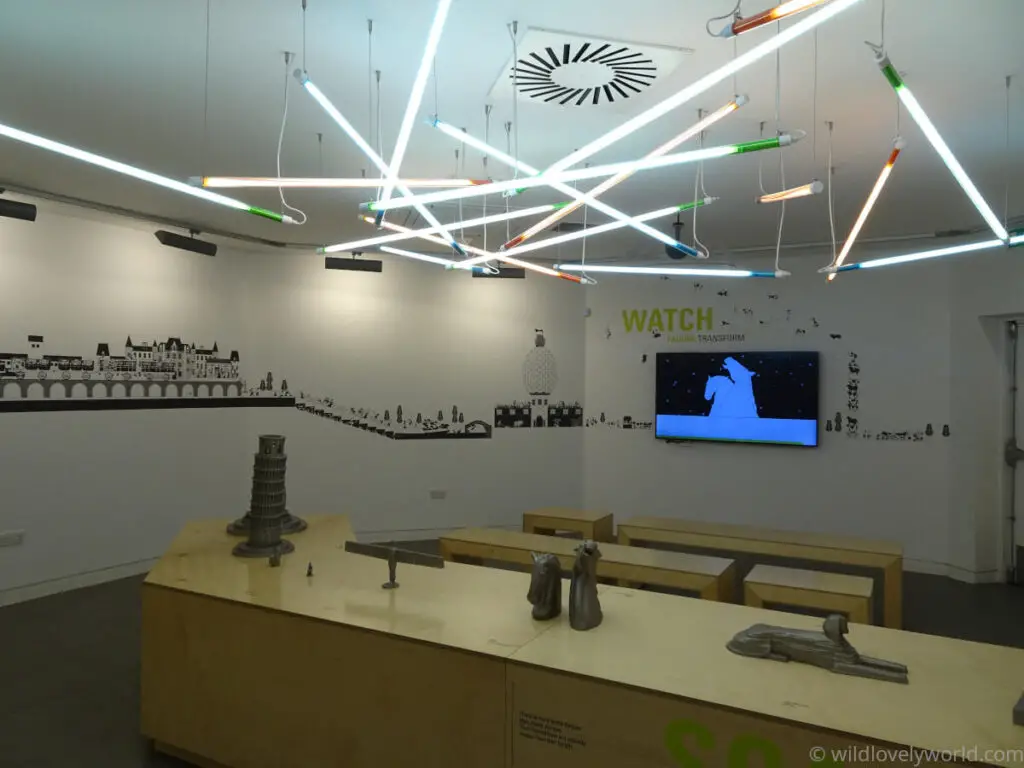
Kids Play Zone & Splash Play Area
The adventure play zone is a big playground at The Helix. The facility is great for kids ages 2 and above.
There is an accessible play area with a sensory play area and a wheelchair-friendly roundabout and see-saw.
Splash Play Zone is a water play area that kids can enjoy in the summer months.
Walking & Cycling (Recommended Trails)
The Kelpies and Helix Park are great locations to go for a walk, run or cycle. There are many km of paths to explore. All the paths are wide, smooth and flat so they are accessible for as many people as possible.
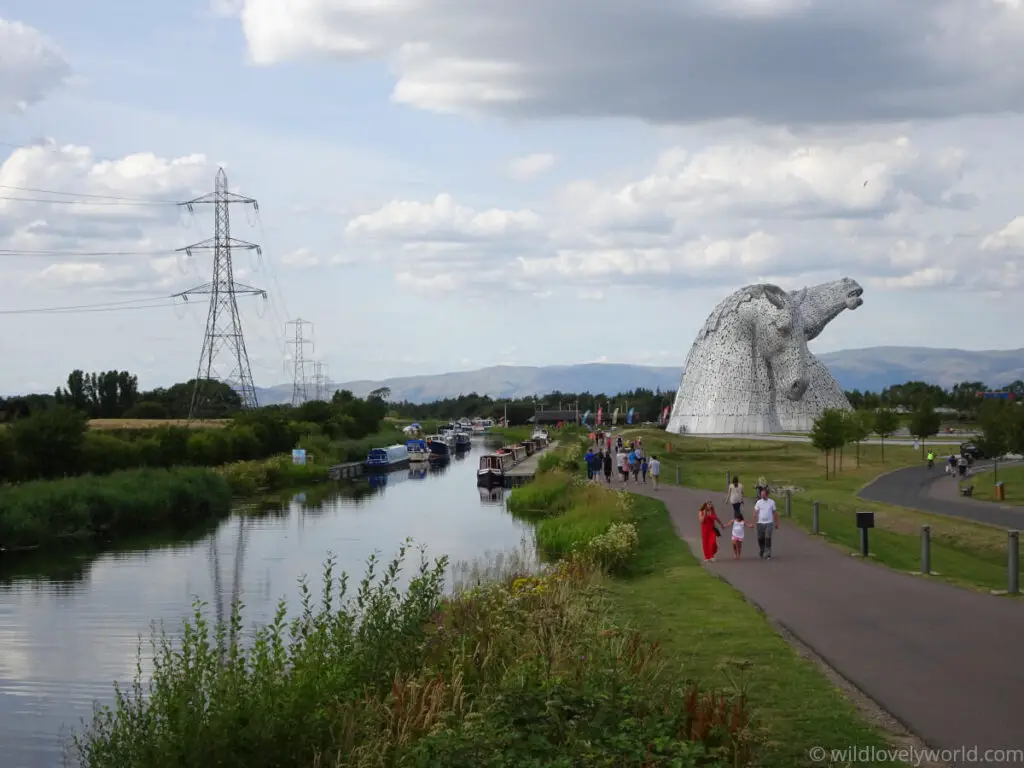
The Kelpies & Helix Park Loop Walk
You can combine your trip to see the Kelpies with a lovely walk around the park and the surrounding canals.
This walk described on Walk Highlands is a nice circular route to do at the Kelpies. Doing this loop walk will take you to scenic spots around The Kelpies and Helix Park.
The loop is 6.25 km and will take around 2 hours.
Charlotte Dundas Trail
Another interesting walking route you can do is the Charlotte Dundas Trail. The heritage trail was established to celebrate the Charlotte Dundas steamboat and her creator William Symington.
The Charlotte Dundas was a commercial steamboat that operated along the canal in 1803. William Symington designed the boat for Sir Thomas Dundas who was the Governor of the Forth & Clyde Canal Company at the time. He named the boat after Sir Thomas Dundas’ daughter Charlotte. The boat is known as the world’s first practical steam-powered boat.
The interesting, historical Charlotte Dundas trail walk starts in Helix Park near the Kelpies and travels along the River Carron and Queen Elizabeth II Canal to Lock 1.
The trail continues onwards to Dalgrain Road (in Grangemouth, another small town next to Falkirk) but a nice section is to do the first portion which goes from The Kelpies to Lock 1. This section is 850 m one-way. If you are continuing to do the full Charlotte Dundas trail then it is a distance of 1.2 km one-way.
Along the 850m path to Lock 1 from The Kelpies, there are interpretive panels that explain the history of Falkirk and Grangemouth spanning over 300 years from the 1700s to the modern day. You can learn about local flora and fauna, the River Carron and the canals, steam-powered boats and the towns of Grangemouth and Falkirk and more!
The Charlotte Dundas trail is sealed and fully accessible for all people and abilities. There are seating areas as well as themed benches along the path.
You can also walk your dog there.
For a great trail map and more information about the Charlotte Dundas and its history, you can visit the website here.
Hartt Cycling Route
If you like cycling, then you may enjoy The Helix Around Tour Route (Hartt Route) is a 25 km cycle route starting and finishing at The Kelpies. The route goes to the Falkirk Wheel and Callendar Park and back to Helix Park. You can see a map and guide of the Hartt Route here.
Cafe, Facilities & Toilets At Helix Park
There are three sets of toilets within the Helix. These locations are at the Plaza Cafe, The Kelpies car park and the Helix Visitor Centre.
The toilets are not always open all of the time and may close at certain times of the day or night.
You can access the Plaza Cafe toilets from inside or outside. They are open from 10 am – 3/4 pm. I believe it is open 7 days a week but I have read they change their opening times frequently so it may be different when you go.
Plaza Cafe serves hot and cold food and drinks, but I wouldn’t rely on it as a place to get your lunch. When visiting The Kelpies, I recommend bringing your own snacks/packed lunch with you, or heading into Falkirk town centre and visiting one of the many cafes, restaurants and pubs to enjoy lunch or dinner.
The Helix Visitor Centre toilets are open during opening hours, so from 9:30 am – 4 pm most times of the year.
The toilets at the Kelpies car park at open from 8 am – 10 pm 7 days a week.
All toilet blocks have an accessible toilet.
Wheelchairs are available free on loan. These can be reserved in advance by phone or email.
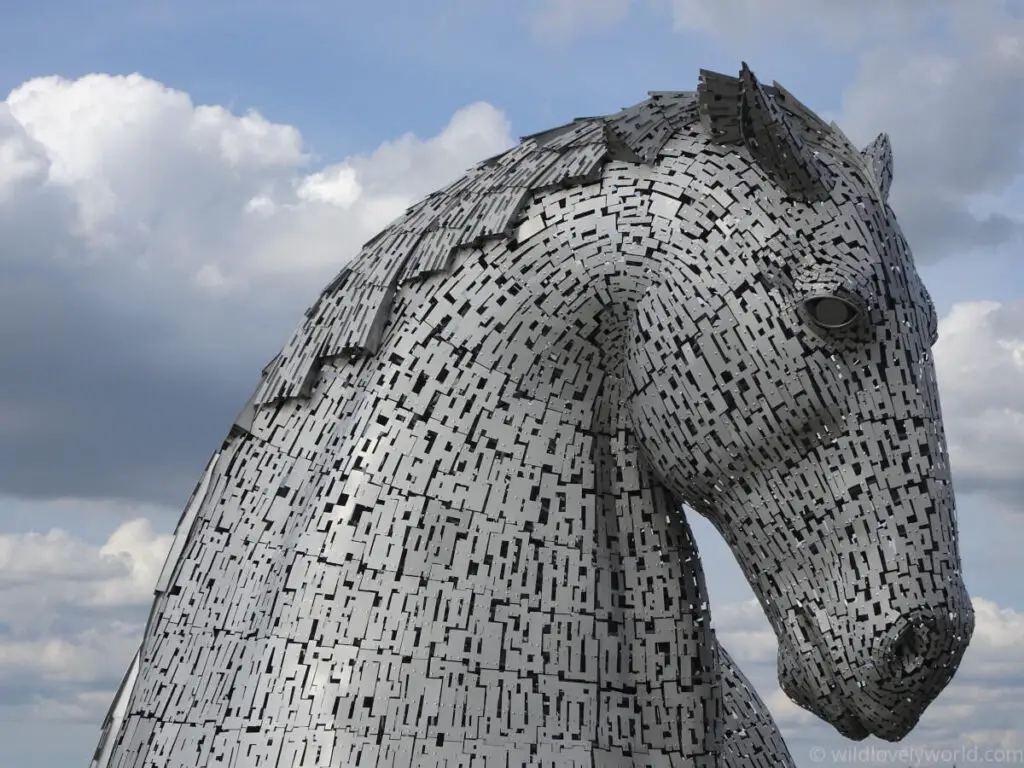
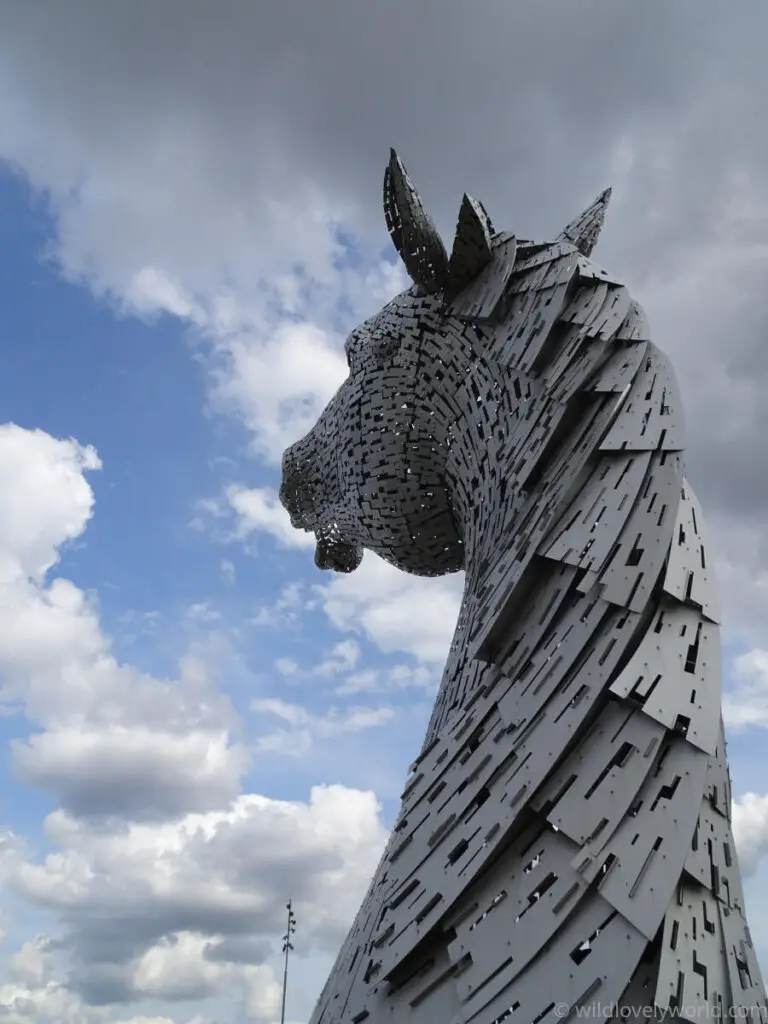
How To Get To The Kelpies In Falkirk
The easiest way to get to The Kelpies is by car. It is also possible to get there by public transport on the train and bus. You could even visit the Kelpies as part of a day tour with a small group and a guide from Edinburgh. I will explain how to get there by all these methods below.
How To Get To The Kelpies By Car From Edinburgh
To travel to the Kelpies by car from Edinburgh:
- Take the M9 motorway towards Stirling.
- Exit at Junction 5 or 6 for Falkirk.
- Then you can follow the brown tourism signs to The Kelpies and Helix Park.
It takes around 45 minutes to drive from Edinburgh to The Kelpies in Falkirk. The distance is around 26 miles / 41 km.
If you need to book a rental car, then I recommend Discover Cars or Rental Cars to search for, compare and book rental cars.
How To Get To The Kelpies By Car From Glasgow
To travel to the Kelpies by car from Glasgow:
- Take the M80 motorway towards Stirling.
- Exit at Junction 8 for the M876.
- Then join the M9 and exit at Junction 5 or 6 for Falkirk.
- Then you can follow the brown tourism signs to The Kelpies and Helix Park.
It takes around 40 minutes to drive from Glasgow to The Kelpies in Falkirk. The distance is around 25 miles / 40 km.
If you need to book a rental car, then I recommend Discover Cars or Rental Cars to search for, compare and book rental cars.
Car Parking At The Kelpies & Helix Park
There’s plenty of parking at the Kelpies and the Helix Park.
The two car parks are the Helix Car Park and the Kelpies Car Park.
All of the car parking used to be free but unfortunately there are now charges (since April 2019). So now you need to pay to use the Kelpies car park at certain times of the year! I explain how much this costs below.
The Helix Car Park (Free & Open 24/7)
The Helix Car Park is still a FREE car park. It is located near the entrance of the Helix Park complex.
The car park can be accessed 24/7 and there are 78 spaces.
From the car park, it is a short and pleasant walk to The Kelpies along the park paths. The walk from Helix Car Park to The Kelpies is around 10 minutes.
Overnight Campervan Parking At Helix Car Park
The Helix Park allows campervans to park overnight in a car parking space at the Helix Car Park.
You do have to pay for the car parking though. Despite that, it is always nice to find places you are welcome to park a campervan overnight!
There are no camping facilities so you need to be fully self-contained.
Campers over 8m are not accepted for overnight parking due to space.
The Kelpies Car Park (Charges Apply & Open 8 am – 8 pm in winter & 10 pm in summer)
The larger Kelpies Car Park is located near The Kelpies sculptures and the Visitor Centre. It has 175 spaces.
It is FREE to park at the Kelpies car park at certain times of the year (read more below). But most of the time charges apply.
The Kelpies Car Park costs between £2 – £6 depending on the vehicle you have, the time of day and the time of year that you visit.
The daytime prices (between 10 am – 4 pm) are more expensive than the night-time prices (between 4 pm – 9:30 pm). Also, visiting from July – August is more expensive than visiting from April – October.
The Kelpies car parking charges are as follows:
- Cars cost £2 at night and £3-4 in the daytime
- Larger vehicles cost £2 at night and £5-6 in the daytime
- Motorbikes can park for FREE at night-time and for £1 during the day
- Blue Badge Holders can park for FREE anytime
How To Get Free & Cheap All-Day Car Parking At The Kelpies
If you visit during the off-peak season, from November – March (winter), then the car parking charges are cheaper.
Cars, large vehicles and motorbikes can all park for FREE all day (day and night) from Monday – Friday.
Car parking charges still apply for cars and larger vehicles on the weekends in winter (Saturday and Sunday, 11 am – 3 pm), as well as for everyone but Blue Badge Holders between 27th December – 8th January (10 am – 4 pm). During those times, it costs between £1-5 to park, depending on whether you have a motorbike, car or large vehicle.
The Kelpies car park is locked overnight so it is not open 24/7. It opens at 8 am and closes at 8 pm each night from November – March and at 10 pm each night from April – October.
For more information on the Kelpies’ car parking charges, you can visit The Helix website here to see their current pricing tables.
Free Car Parking Near The Kelpies In Falkirk
If you don’t want to pay for parking when you visit The Kelpies, then you can park for FREE at the nearby Falkirk Stadium. The stadium car park is only a short walk from Helix Park and The Kelpies.
It will take you around 20 minutes to walk from the Falkirk Stadium to The Kelpies.
The walk is flat and completely safe as it does not go along the road as it uses the Helix Park paths.
It is good to know that you can park at the bigger car park at the stadium as during nice weather and holidays, both car parks at the Kelpies can fill up very early in the morning.
Unfortunately, the Falkirk Stadium car park is not available on match days for the Falkirk Football Club. If you want to check online if there is a match before you visit then you can check out their website here.
How To Get To The Kelpies By Public Transport From Edinburgh & Glasgow
It is possible to get to The Kelpies in Falkirk by public transport, but you will need to take a train and then walk or take the bus.
Remember, with a Railcard you can save up to 1/3 on your rail fares! Learn more about getting cheaper rail fares with a Railcard on their website here.
Train To Falkirk High Station
First, you will need to take the train to Falkirk High train station.
Trains are direct to Falkirk from both Edinburgh and Glasgow with ScotRail (Trainline). The trains are regular so you won’t have to wait too long for the next one during daylight hours.
- The train from Edinburgh Waverley or Haymarket train stations to Falkirk High station takes around 30 minutes. Trains usually operate every 15 – 30 minutes.
- The train from Glasgow Queen Street Station to Falkirk High Station takes around 20 minutes. Trains usually operate every 15 – 30 minutes.
From Falkirk High station, it’s around a 1-hour / 3-mile walk to The Kelpies. Or you can take the bus.
You can search for train times and see how much tickets costs, as well as book them, on Trainline.
Bus From Falkirk High Station To The Kelpies
The number 2 bus for Bo’ness at Slammanan Road is approximately a 2-minute walk from Falkirk High train station. After a 35-minute bus journey, this bus will stop on Falkirk Road opposite Falkirk Stadium (watch out for the pink bus stop). This stop is at the side entrance to Helix Park and from there you can walk through the park to the Kelpies which will take approx 20 minutes.
Alternatively, you can get a bit closer to The Kelpies by then getting the 28 bus to Falkirk/Alloa from the Falkirk Road stop and getting off at Glensburgh Road before Kerse Bridge Grangemouth. From that bus stop it is an approx 8-minute walk to The Kelpies along the canal.
Train To Falkirk Grahamston
There is a train station that is closer to the Kelpies than Falkirk High and that is Falkirk Grahamston. This train station is located around 2 miles from the Kelpies, so it is 1 mile closer than Falkirk High. Trains run here with ScotRail (Trainline).
Trains to Falkirk Grahamston Station from Edinburgh and Glasgow operate less frequently than the trains to Falkirk High. That is because Falkirk High and Falkirk Grahamston are stationed on different train lines/routes and are not connected.
It is possible to get direct trains from Edinburgh and Glasgow to Falkirk Grahamston but they run less often than to Falkirk High which is why I recommend that route first.
From Falkirk Grahamston it will take around 40 minutes to walk to The Kelpies.
You can search for train times and see how much tickets costs, as well as book them, on Trainline.
Bus From Falkirk Grahamston Station To The Kelpies
There are bus services from Falkirk Grahamston station and the Kelpies that take around 25 minutes. You can take bus number 2, 3, or 4 as well as others to The Kelpies.
How To Get To The Kelpies By Bike
There are many cycle paths along the Forth & Clyde Canal which is the location of The Kelpies.
You can take your own bike on the train and cycle from Falkirk High Station to the Kelpies in around 20 minutes.
From The Kelpies, you can cycle west to the Falkirk Wheel along the Forth & Clyde canal in 20 minutes. From the Falkirk Wheel, you can cycle east along the Union Canal to Linlithgow in just over 1 hour, or even cycle to Edinburgh in 2 hours and 45 minutes.
How To Get To The Kelpies On A Guided Tour
If you want to take the stress out of getting there on your own, then why not join a guided tour to the Kelpies? There are several tour companies that operate daily tours to the amazing horse sculptures.
These tours also go further north in Scotland to Loch Lomond and the Trossachs which is often called the ‘Highlands in Minature’. You’ll also get to see Stirling Castle and learn about its history on the way.
There are a few tour companies that run these small group-guided day tours. They are all pretty much the same and may vary a little bit in what they offer.
Guided Tour To The Kelpies – From Edinburgh: Loch Lomond, Kelpies & Stirling Castle Tour
I recommend the Rabbies tour or the Timberbush tour (GetYourGuide). The main difference between these tours is that the Rabbies tour includes the entrance fee to Stirling Castle. On the Timberbush tour, you have the option to do a Loch Lomond scenic boat cruise (an extra fee applies).
You can see more information about these tours and book your tickets through GetYourGuide below:
Check availability for guided tours to the Kelpies from Edinburgh below:
Where To Stay Near The Kelpies In Falkirk
Falkirk is a really cute small Scottish town with regular train links to Edinburgh, Glasgow and Stirling. This makes it a nice spot to spend time overnight outside of Scotland’s main cities.
There are plenty of places to stay around The Kelpies, Falkirk and Grangemouth that will suit all budgets. There are even some accommodations that are within walking distance of the Kelpies!
I only recommend accommodation that has a review score of Very Good: 8+.
Budget £: Recommended Accommodation Options Near The Kelpies
There are no hostels in Falkirk or Grangemouth but there are affordable accommodation options for solo travellers, couples and families. Here are my recommendations:
- Excellent for solo travellers and couples: Premier Lodge is the closest hotel to the Kelpies and Helix Park, located between both Falkirk and Grangemouth. It is only a short 13-minute walk to the Kelpies and even closer to Helix Park! They offer double and twin rooms with TVs and tea/coffee-making facilities. Check availability and rates on Booking here.
- Comfortable self-catering for couples & families: Carmel Apartments is a great self-catering option as they feature a fully equipped kitchen and lounge. The apartments are modern and stylish and located in Falkirk town centre. They are beds for up to 4 adults. Check availability and rates on Booking here.
Mid-Range ££: Recommended Accommodation Options Near The Kelpies
If you want to stay in a traditional Scottish bed and breakfast style accommodation then this beautiful country retreat set in a period building will tick all the boxes:
- Perfect for a romantic couples getaway: The Grange Manor is a 4-star 19th Century coach house located in Grangemouth. They offer traditional rooms with Scottish-inspired decoration. Breakfast can be included. The hotel is only a short 15-minute walk from the Kelpies. Check availability and rates on Booking here.
Luxury £££: Recommended Accommodation Options Near The Kelpies
- Private luxury retreat for large groups: Glenbervie House is a luxury coach house mansion located in Falkirk. It has space for 18 people and you can rent the whole place for yourselves! Check availability and rates on Booking here.
Search for accommodation on Booking using the box below:
Where To Go After Your Visit To The Kelpies In Scotland
You could combine your trip to The Kelpies with a visit to a number of interesting attractions! Here are my recommendations for other places to see close to the Kelpies.
Falkirk Wheel
The Falkirk Wheel is also located in Falkirk and is another major tourist attraction in the area.
The wheel is a rotating boat lift that can transport boats from the Forth & Clyde Canal to the Union Canal. It is an innovative and unique piece of engineering!
You can see the lift rotate as it turns 180 degrees to connect the two canals. There is also a visitor centre, toilets and a cafe. Boat tours also operate so you can experience the lift in action!
The Falkirk Wheel is located about 5 km / 8 miles from the Kelpies. It takes about 15 minutes to drive between the two. Here is a link to the location of the Falkirk Wheel in Google Maps.
Callender House & Park (Outlander Film Location) & Antonine Wall (UNESCO World Heritage Site)
Just down the road from the Kelpies is the beautiful Callender House, a 14th Century French-style chateau with a working Georgian (19th Century) kitchen.
Callender House has gained popularity recently because it was used as a film location for the Outlander TV series!
The house is set in beautiful 170 acres of grounds with woodland, gardens and a golf course. There is also a section of the Antonine Wall which is a Roman-built fortification across what is now the Central Belt of Scotland. The Antonine Wall is a UNESCO World Heritage Site.
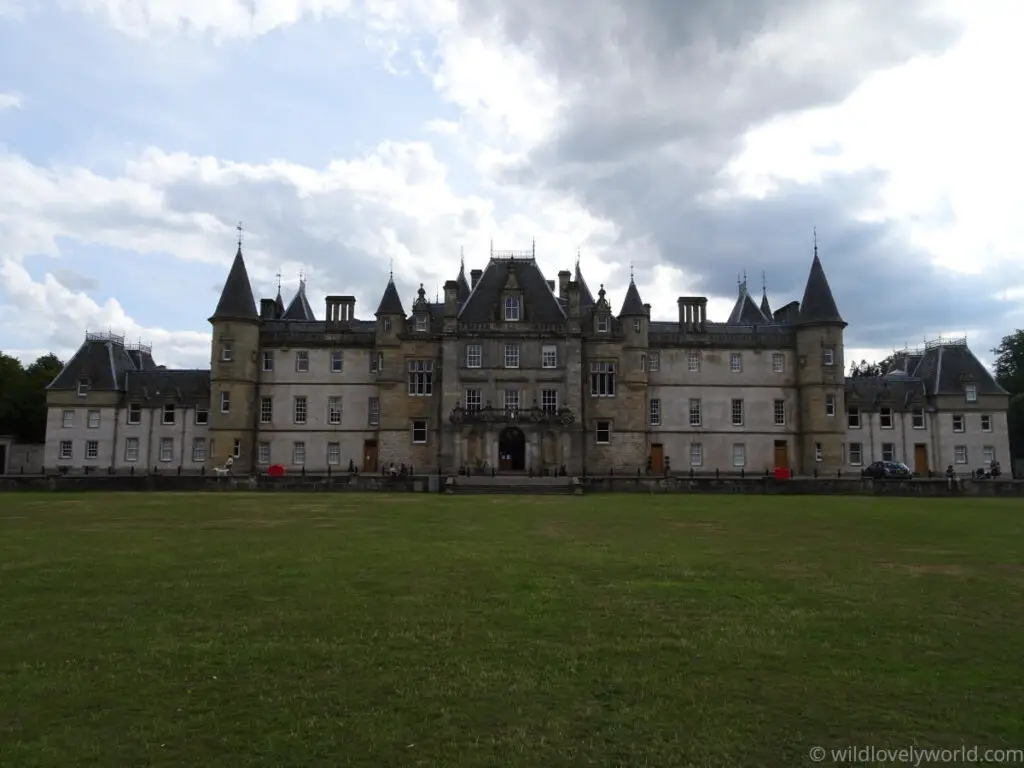
Inside Callender House, you can see an exhibition about the history of the house and the Antonine Wall, and the local area and how it was transformed in the industrial era. Art exhibitions are also on display and change regularly.
In the Georgian kitchen, there are interactive displays and staff in costumes that can explain the stories of working life in a large household in the 19th Century!
There is a tearoom serving afternoon tea (book in advance on their website) and a gift shop too. Callender House is FREE to visit and is open from Monday – Sunday 10 am – 5 pm (closed on Tuesdays).
For the kids, there is a large Roman-themed play park and different seasonal activities.
There are 3 car parks for your car parking and they are all FREE! Callender House is very accessible by public transport as it is just a 20-minute walk from Falkirk Grahamston train station.
For more information on Callender House and what’s on, visit their website here.
Dunmore Pineapple (My Favourite Quirky Tourist Attraction!)
One of my favourite attractions near the Kelpies and Falkirk is the Dunmore Pineapple! This is somewhat of a hidden gem as many people do not know about it! I love how quirky this building is and as you can see in the photo below I really enjoyed visiting it (I am a big pineapple fan!). 🍍🍍🍍
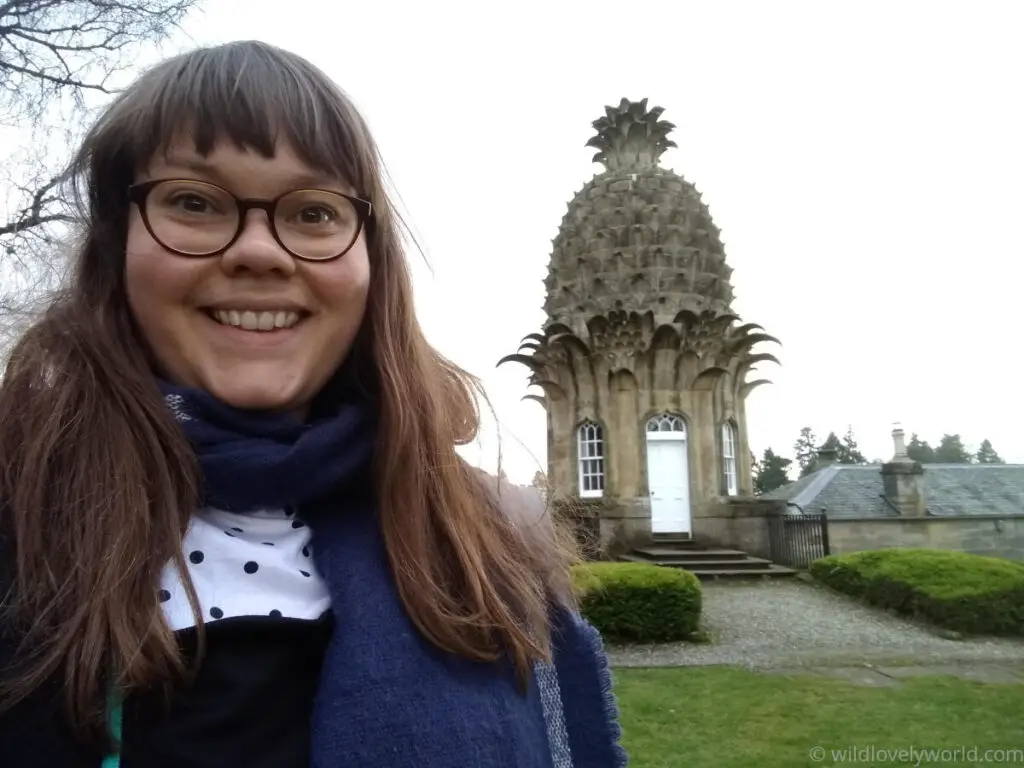
Who lives in a pineapple in Dunmore? Turns out, nobody! The Dunmore Pineapple was built as a folly! A folly is a building constructed purely for the decoration and extravagance of it all!
The bizarre pineapple-shaped building was built in the 18th Century and commissioned by John Murray, the 4th Earl of Dunmore. The building was used by him and his wife Charlotte as a kind of summer house where the family could appreciate the views of his grand estate. At the time, pineapples were a new and exciting exotic and interesting fruit and were used in many decorations and motifs.
The Pineapple is set within a walled garden. You can’t go inside the Pineapple itself but you can enjoy the gardens. There are crab apple trees and woodland to explore.
The Dunmore Pineapple is under the care of the Landmark Trust. They have converted the building into a holiday cottage you can rent and stay in! You can find out more about how to stay there here on their website.
Dunmore Pineapple is a short 30-minute drive from the Kelpies/Falkirk/Grangemouth. It is a distance of about 9 miles / 14 km. Here is the location of the Dunmore Pineapple in Google Maps.
It is also possible to get there by bus from Falkirk. See how to get from the Kelpies to the Dunmore Pineapple by public transport here on Google Maps.
Dunmore Park House (Abandoned Ruins & Outlander Film Location)
Nearby to the Dunmore Pineapple is the abandoned ruins of the Dunmore House and the Elphinstone Tower.
The Dunmore House was built in the 1820s and used as a private family residence for George Murray, the 5th Earl of Dunmore, and his family, until 1911. It was then purchased by another family and they used it until the 1960s. It was briefly used as a girls’ school for a couple of years before being totally abandoned in 1964.
Dunmore House now lies in a state of ruin! It is an easy location to find (Google Maps) and explore if you are interested in Urbex and abandoned buildings (I know I am!). When I visited, I found it to be a pretty spooky experience.
The whole building is surrounded by fences but it is easy to find a way in. Just be careful because the whole building is crumbling and dangerous.
Dunmore Park House was also used as a film location for the Outlander TV series. You can see a scene from the TV show on location at Dunmore House on this Outlander Filming Locations blog here.
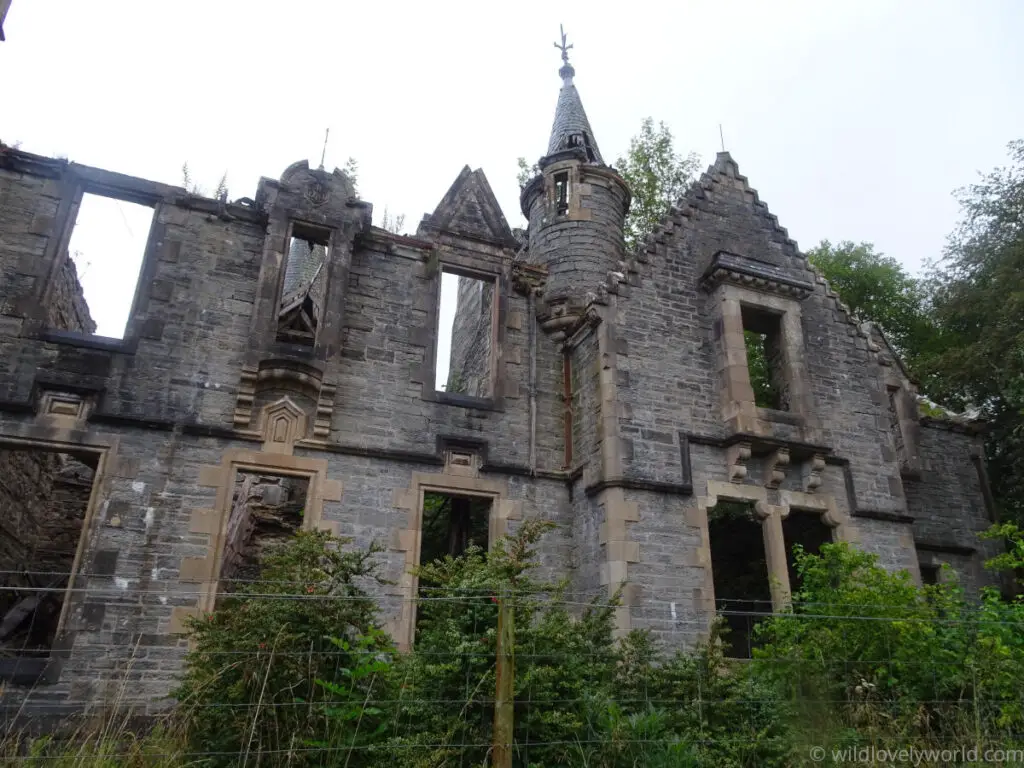
Elphinstone Tower (Abandoned Ruins)
Nearby is the Elphinstone Tower, also known as Dunmore Tower, Dunmore Castle, and Elphinstone Castle.
The tower building was originally built as a private residence in the 16th century for Sir John Elphinstone. In 1754, John Murray, the 4th Earl of Dunmore, purchased the tower for £16,000. The whole estate then became the (Lord) Dunmore Estate. The Murrays did not use the tower as a residence but in the 1850s the ground floor of the tower was remodelled into a family burial vault. St Andrews Episcopal Church, a private chapel, was built next to the tower at the same time. The church was demolished in the 1960s leaving the ruined tower building standing alone.
In April 2023, it seems that a couple from the UK/US purchased Elphinstone Tower. They say they have “no idea what they’re getting into”, but they have a website set up and seem like they have some big plans!
I visited the site of Elphinstone Tower a few years ago, but now it has been privately purchased I am not sure if it is still open to visitors.
Linlithgow Palace & Loch (Highly Recommended, & Yet Another Outlander Filming Location)
Another one of my favourite day trips from Edinburgh is to the Linlithgow Palace. This wonderful historic palace is set on the edge of the Linlithgow Loch.
The palace was used as a royal residence by the monarchs of Scotland for centuries until the monarchy of England and Scotland was united in 1603 and moved to London. Today, the Palace is a ruin inside but much of the structure of the building remains.
Mary, Queen of Scots, was famously born at the palace in 1542 and she lived there as well for a time. The palace is said to be haunted by Mary’s mother, Mary of Guise!
You can enter Linlithgow Palace for a small fee (£10 per adult – Historic Scotland). Inside the palace, you can explore the ruined rooms and imagine what it used to be like. There are interpretative panels guiding you around.
You can even climb up onto the top of the palace and get a great view of the loch and the surrounding area for miles.
One of my favourite features of the Linlithgow Palace is the courtyard where there is an intricately decorated fountain.
The Linlithgow Palace is open at the following times:
- April – September daily 9:30 am – 5:30 pm
- October – March daily 10 am – 4 pm
- Closed 25th – 26th December and 1st – 2nd January
I’ve been to the annual jousting event at Linlithgow Palace which is a very interesting experience! It is like a medieval fair and there are knights riding on horses having jousting battles. The event is held in July.
The Linlithgow Palace is yet another Outlander filming location!
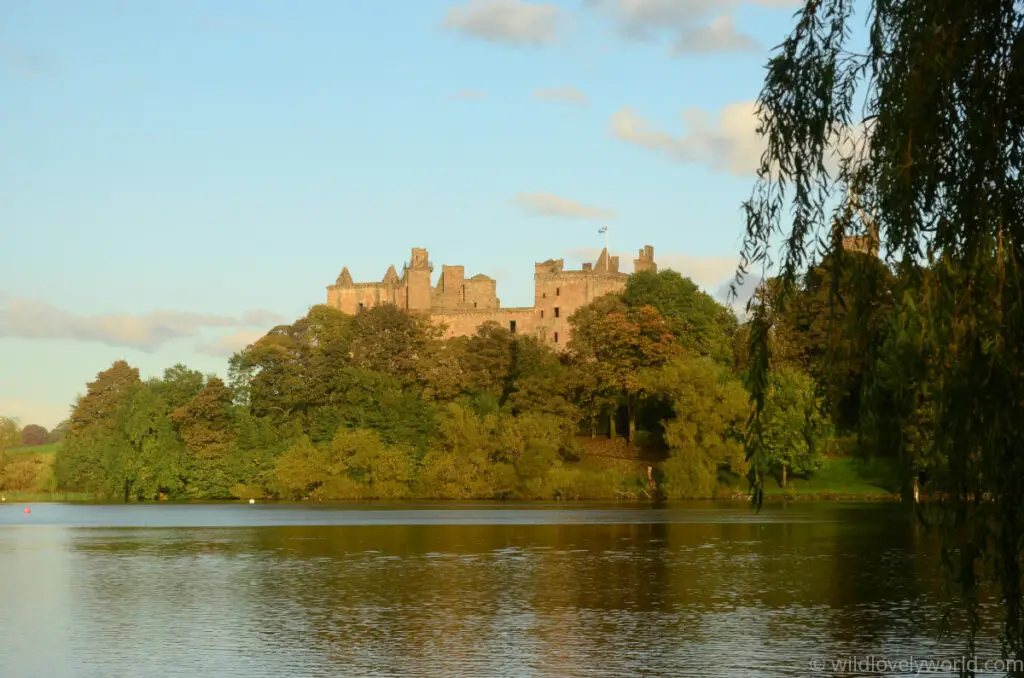
Linlithgow Loch Walk & Town
There is a walking path that goes all the way around Linlithgow Loch. The walking path is easy, flat and takes around 1 hour to complete in a loop, starting and finishing at Linlithgow Palace. You can get directions for this walk on Walk Highlands.
The whole area is very picturesque so you can get some great photos. An excellent photo spot is on the opposite side of the lake. From there you can get a great view of the Palace.
The town of Linlithgow is very quaint and cute with lovely little shops and cafes. You may want to go out for lunch to one of the cafes or take a packed lunch and enjoy it by the lake.
You can get to Linlithgow on the train from Edinburgh very easily. The trains running to Falkirk (to go to the Kelpies) pass through Linlithgow from Edinburgh. Services are run by ScotRail. Find train times and buy your tickets online at Trainline. The Palace and Loch are a very easy 5-minute walk from the Linlithgow train station.
Blackness Castle (Yep, You Guessed It! It Was Also Used In Outlander!)
A visit to Blackness Castle makes a great half-day trip from Edinburgh or Stirling or a side trip from Falkirk and The Kelpies. This pretty castle is situated right on the coastline of the Firth of Forth. It is a 15th-century fortress that is known as the “ship that never sailed” because of its prominent location on the shoreline. Visiting Blackness Castle is a really lovely experience. You can get great views across the Firth of Forth.
You can pay to go inside Blackness Castle (£7.50 per adult – Historic Scotland). Inside there are interpretive panels that explain the history of the castle. The inside of the castle is not as impressive as others in Scotland, so if you can’t do it all then I would recommend skipping this one and saving your money for one of the other more impressive castles in Scotland! However, visiting Blackness Castle and seeing it from the outside is still a really lovely way to spend half a day.
Blackness Castle is open at the following times:
- April – September daily 9:30 am – 5 pm
- October – March daily 10 am – 4 pm
- Closed 25th – 27th December and 1st – 3rd January
While you’re in Blackness, I recommend The Lobster Pot (location in Google Maps) for lunch or dinner. They have cosy and interesting decorations inside and a tasty pub menu with a seafood twist!
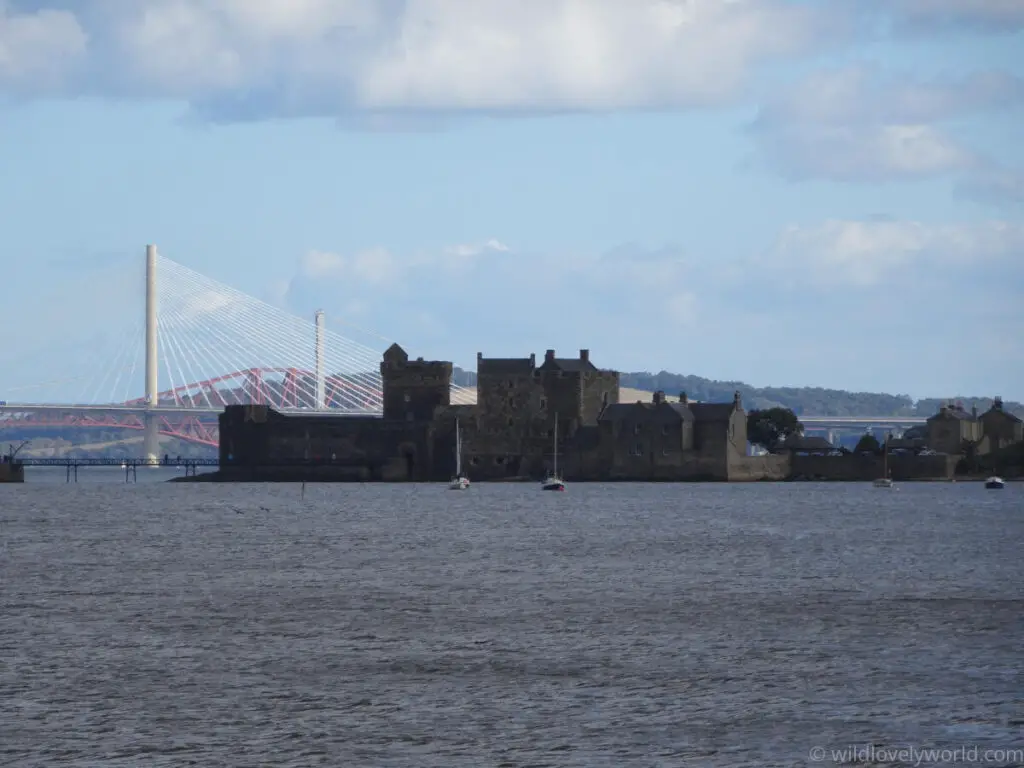
Walk From Bo’Ness To Blackness Castle
A nice thing to do is to walk from Bo’ness to Blackness Castle. The walk follows the coastline all the way and is very easy. The path is level most of the way. The walk takes about 1 hour one way and is around 4.8 km. You can learn more about this walking route and see pictures on Walk Highlands.
Stirling Castle
I’ll tell you a secret. Stirling Castle is way better than Edinburgh Castle! That’s right! If you had to choose between the two, Stirling Castle would win hands down!
Stirling Castle is one of the largest and most impressive castles in the whole of Scotland! The castle is very well preserved and has been refurbished. There are many rooms you can visit, including the largest medieval banqueting hall ever built in Scotland.
The castle was Mary Queen of Scots’ childhood home and her dad James V turned the castle into a beautiful and majestic palace. The castle has a lot of interesting features and is elaborately decorated.
The views from the castle are wonderful as the castle sits on top of a volcanic crag.
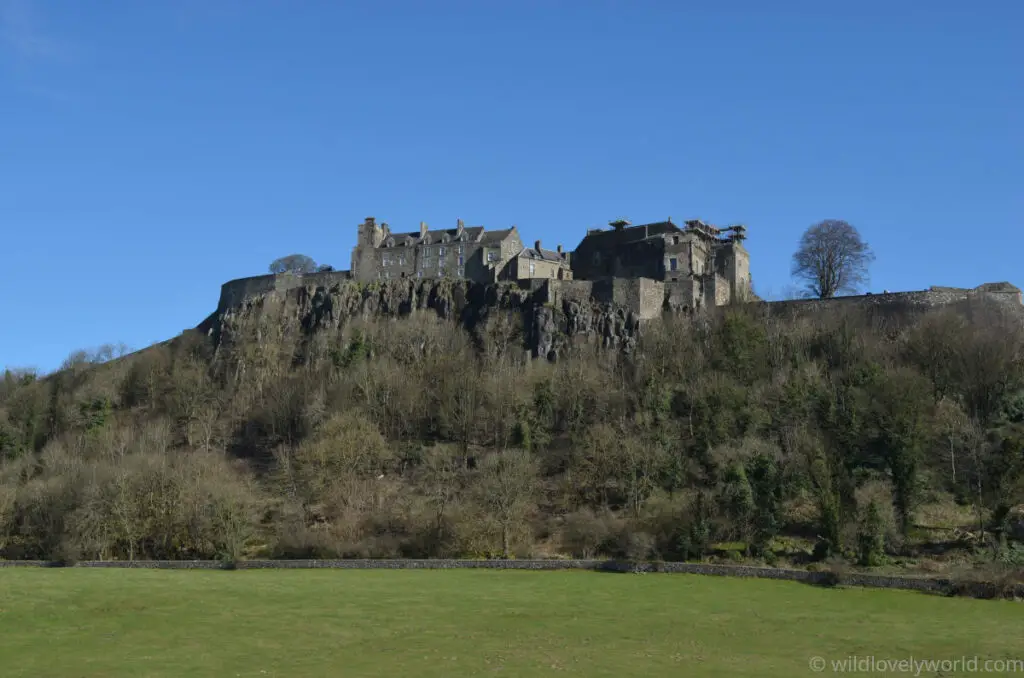
Entry tickets to Stirling Castle are £2 cheaper if you book them online before you go. Adult entry is £17.50 online and £19.50 walk-up price. Book your tickets online at Historic Scotland.
Stirling Castle is a 30-minute train ride from Falkirk. From Stirling train station it is a short 15-minute walk to the castle. You can search for timetables and tickets with ScotRail on Trainline here. You’ll get 25% off the admission price when you book your entry ticket online and show your train/bus ticket on arrival! Visit Historic Scotland to find out more.
The drive from Falkirk and The Kelpies to Stirling Castle is only 30 minutes and about 18 miles / 29 km.
Stirling Castle is open at the following times:
- April – September daily 9:30 am – 6 pm
- October – March daily 9:30 am – 5 pm
- Closed 25th – 27th December and 1st – 3rd January
You’ll need many hours to visit Stirling Castle because it is just so awesome! 🙂
National Wallace Monument
Just a short drive from Stirling Castle is the National Wallace Monument. The huge monument is a 67-metre-high tower on top of a hill overlooking the city of Stirling.
It is one of Scotland’s most impressive landmarks. You can easily see the National Wallace Monument from a distance from many locations around Stirling.
It is FREE to go and look at the National Wallace Monument! There are paths around the hill that you can walk around. You’ll be able to see the architecture of the monument and enjoy the views!
If you want to walk up to the top of the monument (yes, you can do that!) then you will need to pay an entrance fee (£11.30 per adult). There are 246 steps to climb to the top, and you’ll be rewarded with amazing views of Stirling and the surrounding Scottish hills. There is a beautiful crown-shaped dome at the top of the monument, and there are galleries within the monument itself.
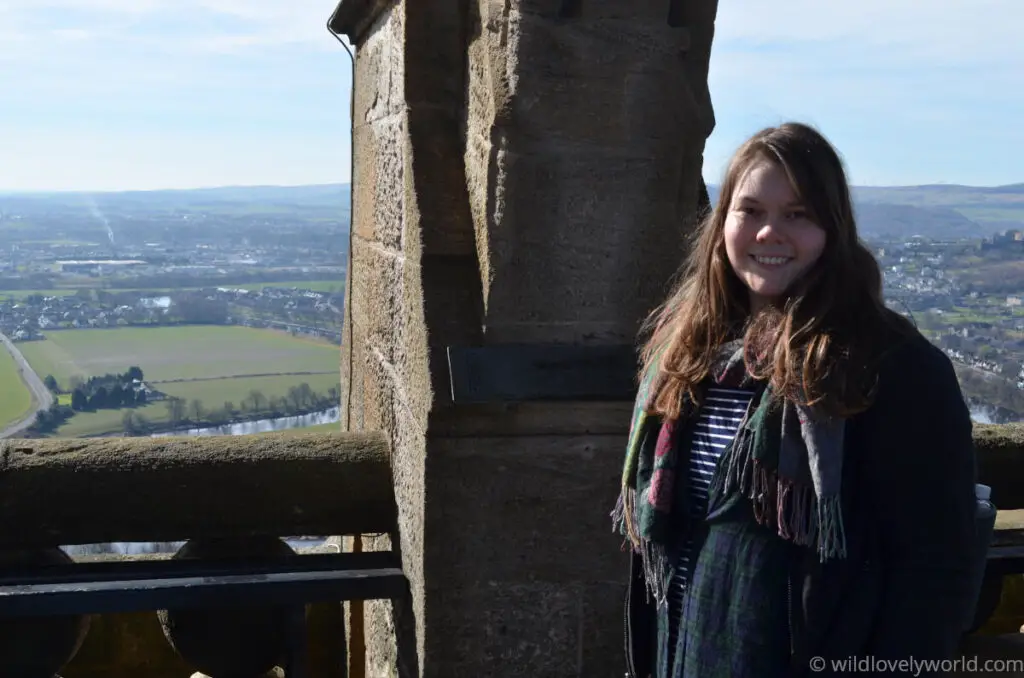
The opening times of the monument change throughout the year so the best idea is to check their website here.
A visit to the National Wallace Monument can be a quick road trip rest stop or a half-day activity. Here is the location in Google Maps.
Loch Lomond & The Trossachs National Park
A trip to the Kelpies is a popular rest stop on road trips from Edinburgh to Loch Lomond and The Trossachs National Park.
The area is known as the “Highlands in Minature”. There are beautiful lakes, rivers, forests, mountains and quaint Scottish villages to visit.
If you have limited time in Scotland and want to get a taste of the Highlands, then a visit to Loch Lomond and The Trossachs will satisfy most people!
From Falkirk, the drive to Loch Lomond and The Trossachs National Park takes around 1 hour and is a distance of 45 miles / 72 km. It is possible to do it as a (very long) day trip, but I recommend doing this as an overnight trip.
There is far too much to recommend for this beautiful part of Scotland. It is deserving of a travel guide in itself, so watch this space for more blog posts coming soon!
For now, check out the Loch Lomond and The Trossachs National Park website for itinerary ideas and travel tips!
If you want to see this area of Scotland as part of a guided tour, then check out this guided tour from Rabbies and this one from Timberbush.
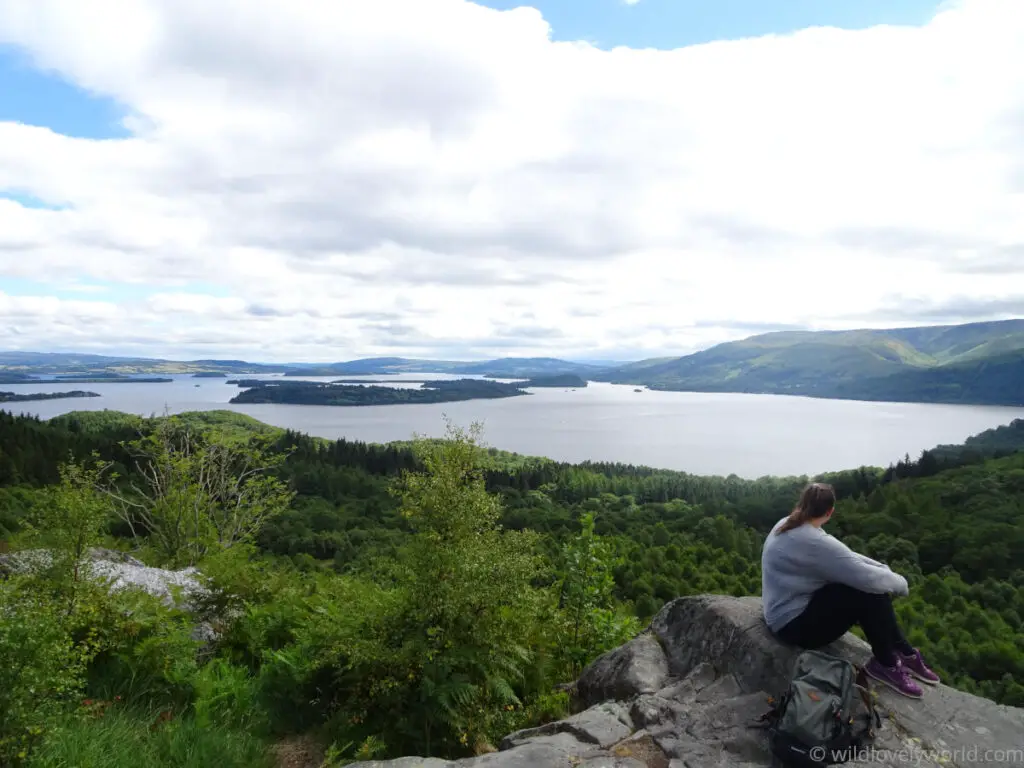
The Kelpies & The Helix Park In Falkirk, Scotland Travel Guide – Thanks For Reading!
Thanks so much for reading this complete travel guide about The Kelpies in Falkirk! As you now know, this amazing spot is a special place to visit that has captured the hearts of many travellers to Scotland. There are plenty of awesome things to see and do at The Kelpies and Helix Park and beyond. I hope you found this guide useful and enjoy your trip! – Lauren x
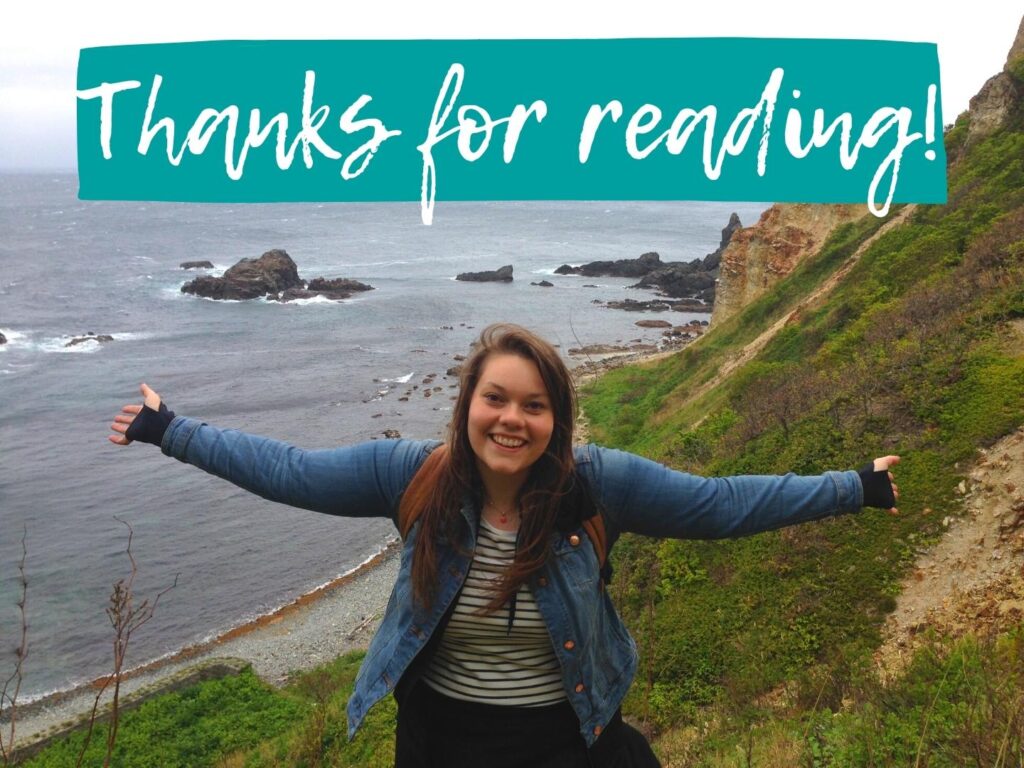
Did you find this article useful? Let me know in the comments or join me on Twitter, Facebook, Pinterest and Instagram. Buy me a coffee here!
If you enjoyed this post, share it with a friend! 💌
Read more of my blog posts about Scotland:
- The Best Hikes & Walks From Corrour Station
- Corrour Station: How To Get There On The West Highland Line
- 13 Best Free Things To See & Do In St Andrews | Scotland
- Autumn In Edinburgh: The Best Places To See Colourful Leaves
- 11 Awesome Things To Do In Corrour & Loch Ossian
- Silver Sands: The Best Beach On The Isle Of Arran
- 7 Best Wild Camping Sites On The Isle Of Arran
- The Kelpies In Falkirk: Visit The World’s Largest Horse Sculptures


